Many trails and lookouts in the Blue Mountains are currently closed following a major landslide in Wentworth Falls and two years of heavy rains. Check local alerts for trail closures before heading to the Blue Mountains.
The Greater Blue Mountains are all about stunning viewpoints and lookouts. There are entire trails that travel along clifftops and could be considered multi-kilometre-long lookouts, like the Clifftop walks in Katoomba and Blackheath. If you have done some of these walks and visited a few lookouts, many of the viewpoints start to look like more of the same thing.
So, to get the most out of your time in the Blue Mountains it’s best to visit a few different kinds of lookouts. There are popular lookouts in the Blue Mountains that are usually fenced off, crowded but offer stunning views. Then there are the wilder lookouts, those that are not as well-known, have no protective railing and retain the wilderness feeling. Some lookouts give you sweeping 180-degree views of deep valleys, while others bring you close to the towering cliffs or give you a view through dramatic openings in the rocks.
READ MORE: Things to do in the Blue Mountains by train
Another way of getting a mix of different views is to visit the lookouts that overlook different valleys. Most of the lookouts in the Blue Mountains National Park look out onto one of the three valleys: Jamison Valley (from Wentworth Falls to Katoomba), Megalong Valley (Katoomba to Meadlow Bath) and Grose Valley (between Great Western Hwy and Bells Line of Road).
Here are some of my favourite epic lookouts in the Blue Mountains that reveal different sides of this stunning World Heritage-listed landscape.
For ease of planning, the lookouts in this guide are organized by area, starting from Wentworth Falls to Jenolan Caves and Kanangra-Boyd National Park.
If I was to rate them by my personal preferences, these would be my top choices:
- Butterbox Point, Leura
- The cave underneath Lincoln’s Rock, Wentworth Falls
- Boar’s Head Climbing Area, Katoomba
- Hassans Walls, Lithgow
- Prince’s Rock, Wentworth Falls
- Castle Head, Katoomba/Narrowneck Plateau
Princes Rock Lookout – Waterfall View, Wentworth Falls
Walking time – 30-45 min (746m return). Location on the map.
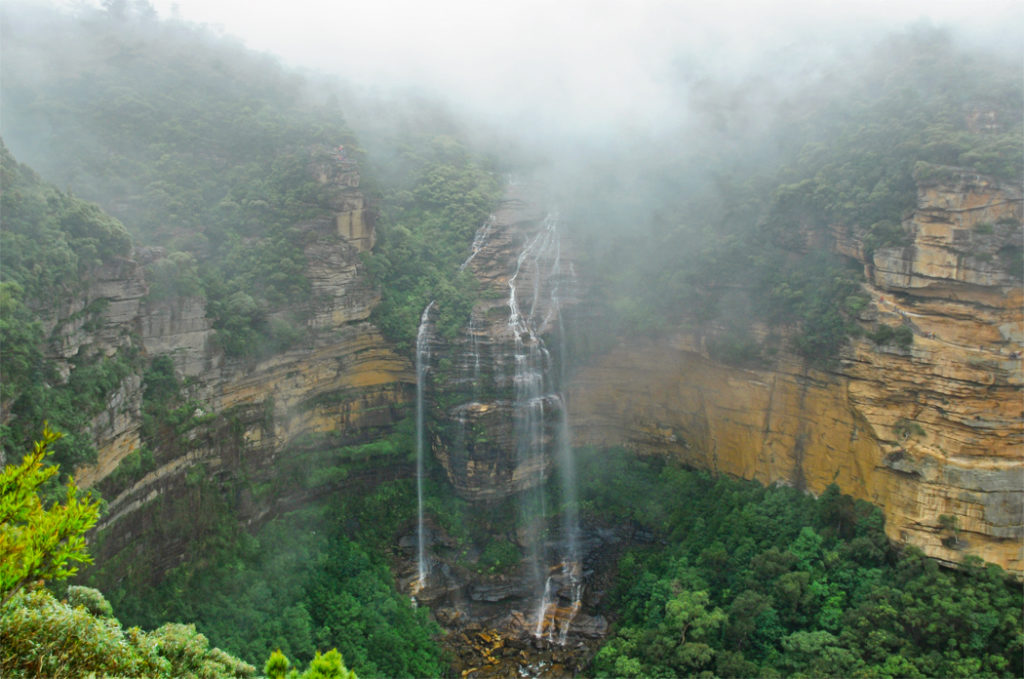
To see the entire first drop of Wentworth Falls, head to Princes Rock lookout via Hippocrene Falls walking track from the Wentworth Falls picnic area. This popular lookout is set further from the falls and gives a wider view of the concave sandstone wall from which Wentworth Falls drop 187 meters to the valley below.
To the right of the falls, the sweeping view of Jamison Valley lets you appreciate the incredible vastness of the surrounding landscape. This is a good lookout to visit after the rain to watch thick layers of mist rise from the valley to the clifftops lending a mystical feeling to the scene.
Fletcher’s Lookout – Jamison Valley, Wentworth Falls
Walking time – 45 min-1hr (1.6 km return). Location on the map

Just a short walk from the Wentworth Falls picnic area, Fletcher’s lookout makes you feel like you are looking into Jurassic Park. It is a narrower view over Jamison Valley, bookended by two cliffs. To the right, an enormous sandstone wall towers over the valley. Its somewhat concave shape and thick cover of lush green forest give it an unusual primeval appearance. To the left, one of the Blue Mountains’ most epic waterfalls – Wentworth Falls flows over a 187-meter cliff.
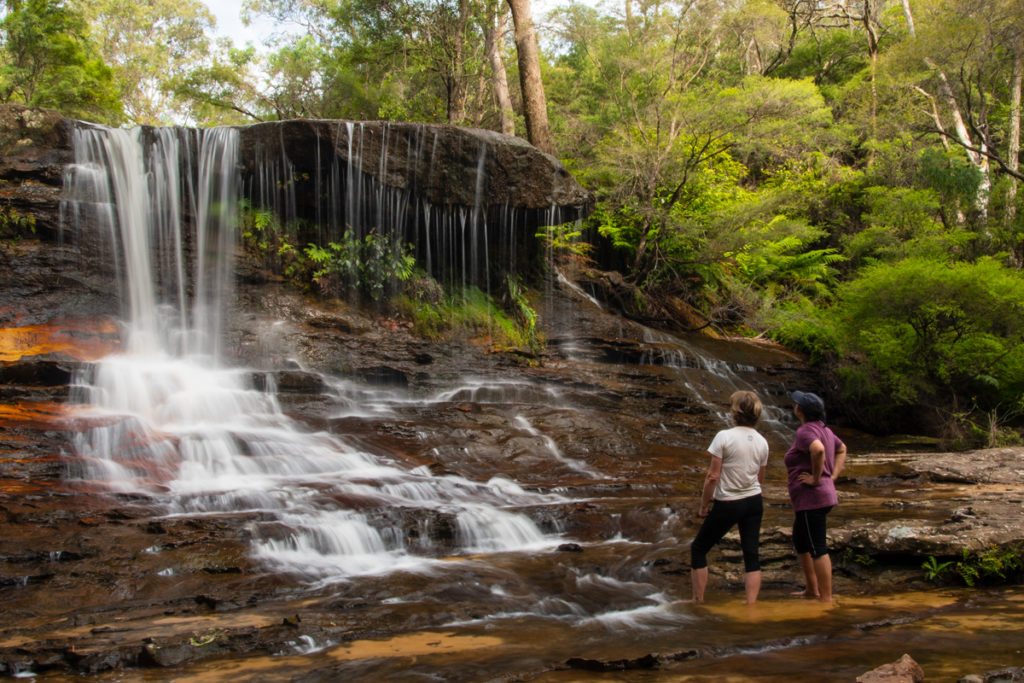
The bonus of visiting Fletcher’s lookout is that you get 3 views in one spot. A 5-minute walk downhill brings you to the picturesque Weeping Rock Falls formed by Jamison Creek just before it tumbles over the edge of a cliff. Another 5-minute walk takes you to the top of Wentworth Falls where you find another cascade on the creek and a set of stepping stones to walk over the top of the big waterfall.
Cave underneath Lincoln’s Rock, Wentworth Falls
Walking time – none. Location on the map
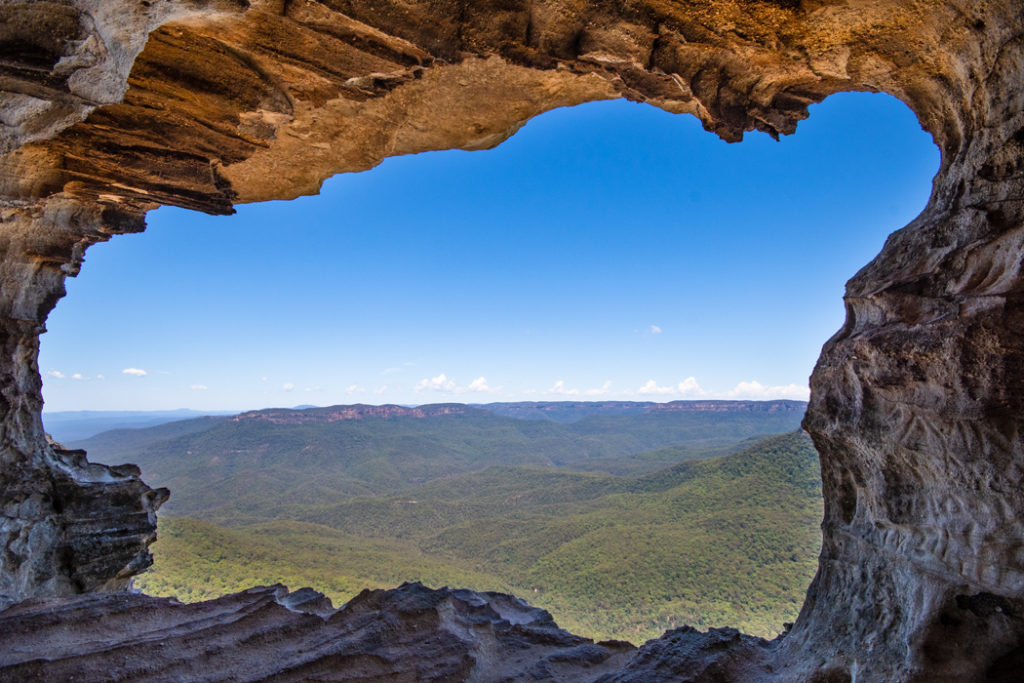
This is a different kind of a lookout and a bit of a secret spot. This little cave is concealed underneath Lincoln’s Rock lookout and it takes a bit of climbing to get to. You don’t need to be a rock climber, but if you never climbed before, make sure you visit with someone who knows what they are doing.
To find the cave, walk onto Lincoln’s Rock and head for the bushes on the left-hand side. There is a trail leading down that takes you past a partially concreted cave to a small flat area directly underneath the lookout. About halfway up the rock wall, you’ll see a wide cave opening. This is the spot. Before you start climbing up, consider that you will have to climb down (backwards) without being able to see where you are going. If you have any doubts, please, don’t attempt the climb. Come back next time with someone who can help you get up and most importantly down from the cave.
The cave is quite small, so you will need a wide-angle lens (10mm or wider) to get the ‘window frame’ view for your shots.
Lincoln’s Rock Lookout – Jamison Valley, Wentworth Falls
Walking time – none. Location on the map
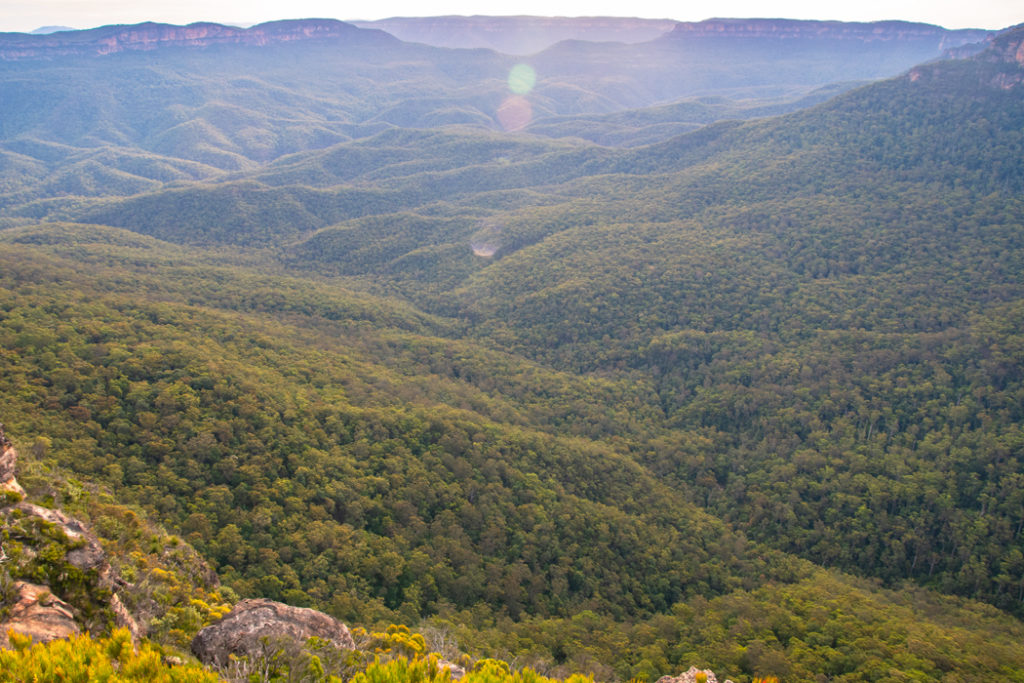
Above the cave, Lincoln’s Rock is one of the most popular lookouts in the Blue Mountains, so it’s likely to be quite busy. The lookout is a flat cliff top with wide-open views over Jamison Valley. The main attraction of this lookout is a protruding rock ledge that people like to sit on and have their photos taken. On a photograph, it looks like they are sitting on the pointy edge of a cliff. In reality, there is a natural safety ledge below that would catch you if you were to fall.
Personally, I am not too comfortable with extreme cliff edges, and prefer to sit slightly away from the edge and enjoy the sunset over the valley. But whether you like living on the edge or not, the view of undulating tree-covered hills from Lincoln’s Lookout is one of the best in the Blue Mountains. And the lack of fences and any kind of man-made structures makes Lincoln’s rock appear wilder than some of the other lookouts.
Butterbox Point – Grose Valley, Leura
Walking time 1hr (3km) return. Location on the map
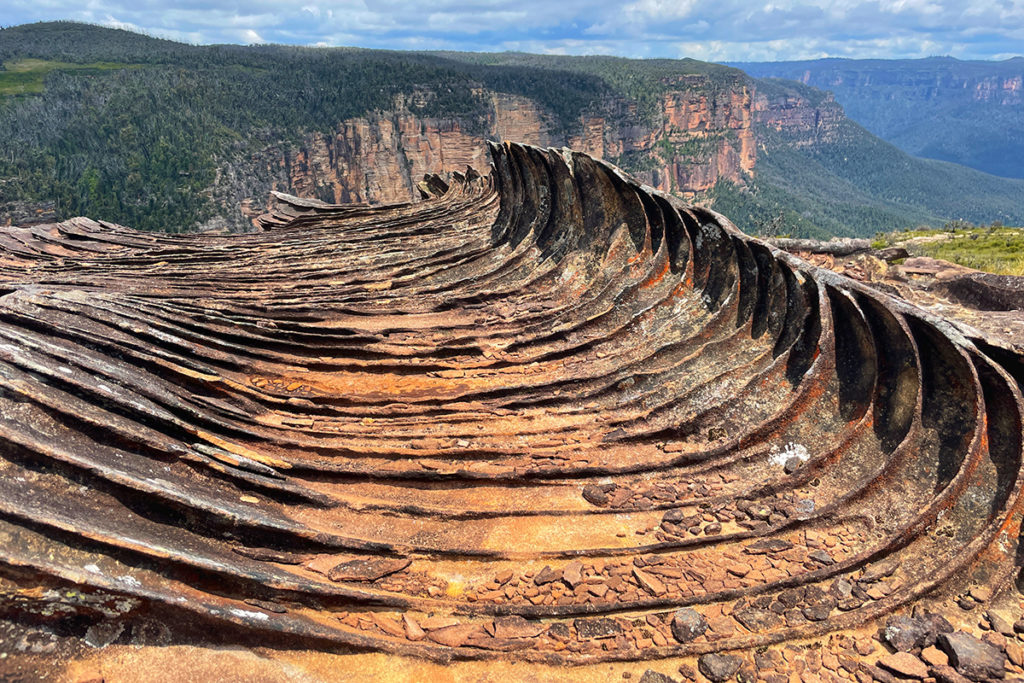
Butterbox Point is not a very well-known lookout, but it is one of the most striking and unusual ones. Not only does it offer spectacular views over the wild and inaccessible section of Grose Valley, but it is also the location of some of the most dramatic rock formations in all of the Blue Mountains.
The combination of sandstone platforms and layers of ironstone exposed by erosion created an alien landscape of razor-sharp stone swirls and jagged waves. One area looks like the ruins of a Roman amphitheatre with remnants of the circular spectator tribunes around a jagged centrepiece.
Another is similar to a whale carcass lying on its back with its baleen bristles expanded. Yet another, looks like the remnants of a huge wooden boat. Some formations look like petrified water ripples, others like swirls of breaking waves. All this extravagance is set against the background of an enormous sandstone wall and the green expanse of the Grose Valley below. It is a surreal landscape of rocks fashioned into frivolous shapes as if they were made out of butter. You could spend half a day here exploring all the different formations and still not see them all.
Reaching Butterbox Point requires a 4WD to cover 13 km of unsealed Mount Hay Road. For more details, read my guide to Visiting Butterbox Point.
The Three Sisters – Jamison Valley, Katoomba
Walking time – none. Location on the map.

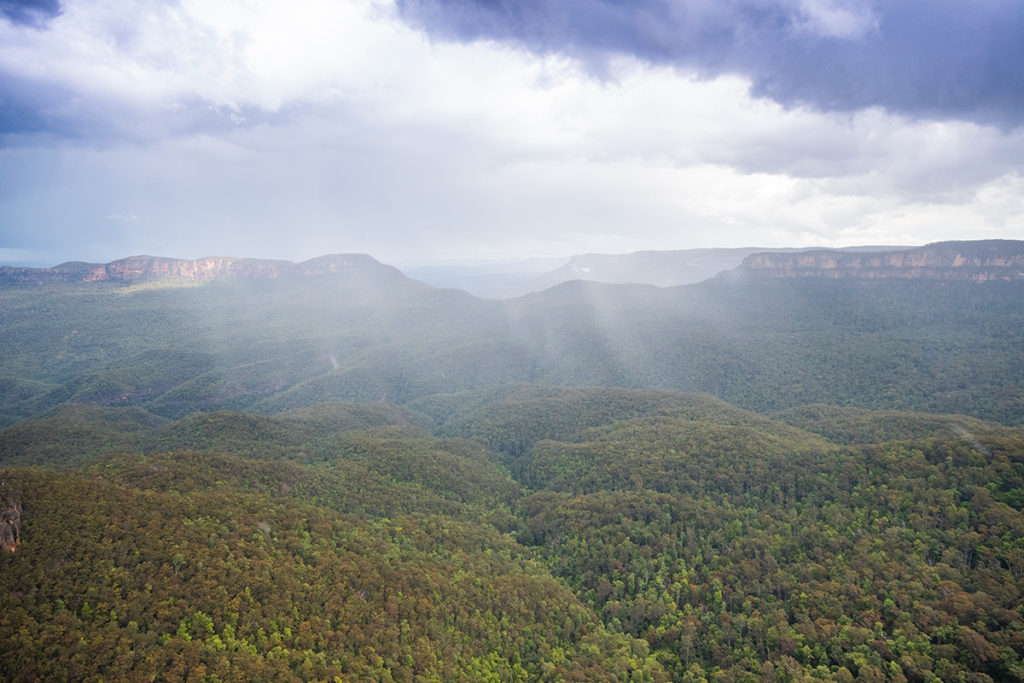
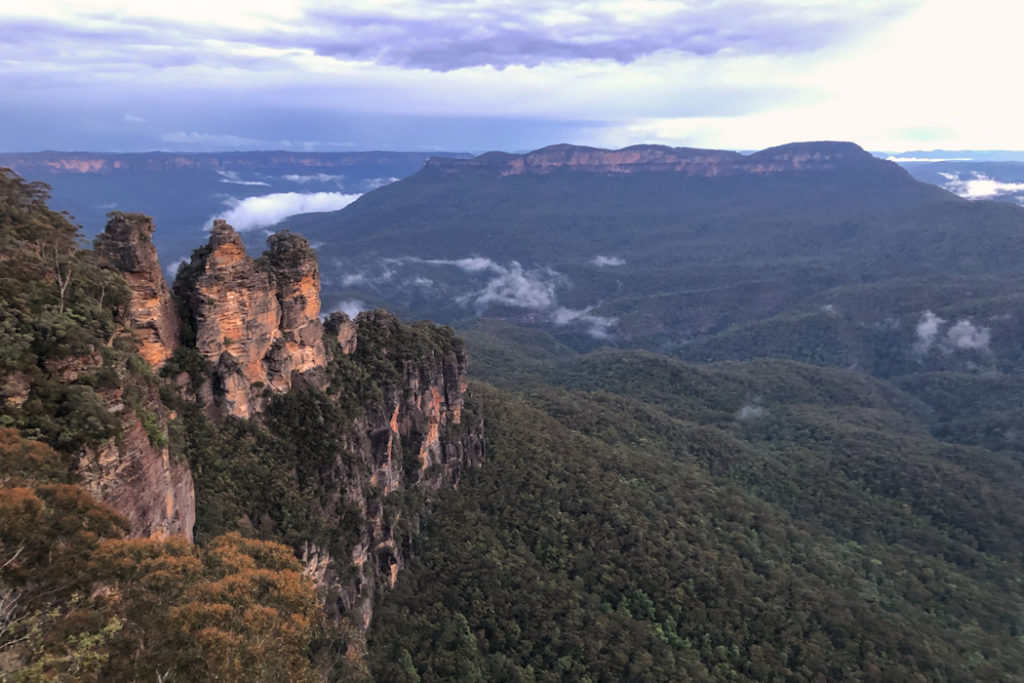
The Three Sisters lookout at Echo Point in Katoomba is the most popular of all the Blue Mountains lookouts, and for a good reason. Not only does it offer you a sweeping view over the Jamison Valley fringed by Mt Solitary, but it also reveals a rock formation dramatic enough for the Aboriginal custodians of the land to have a legend about its formation. The three weathered sandstone towers known as the Three Sisters are the most recognizable landmark in the Blue Mountains.
The downside to Three Sisters’ popularity is that it is the single most crowded spot in the mountains. Echo Point, where the lookout is located, is the tourist hub of the Blue Mountains outfitted with a visitor centre, a mall, and a car park big enough to accommodate the steady flow of tourist buses.
The only time I found Echo Point virtually deserted was on a stormy day during the covid pandemic. It had been raining since morning, so no Sydneysiders travelled to the mountains that weekend. Watching a rainstorm move in over the mountains is one of the most dramatic sights you can get in the Blue Mountains. So if you find yourself in the area on a rainy day, take a trip to Echo Point and enjoy having the Three Sisters lookout to yourself.
Cahill’s Lookout – Megalong Valley, Katoomba
Walking time – 2 min (500 meters). Location on the map.
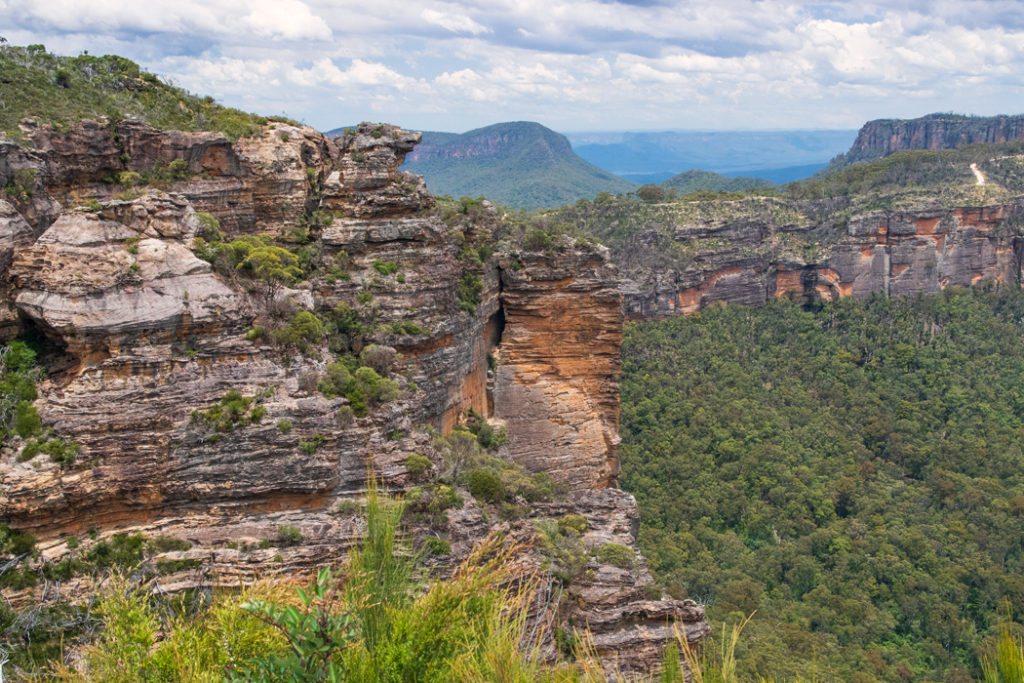
Until a few years ago, Cahill’s lookout was more of a secret spot than a mainstream destination. Today there is a sealed path, a picnic area and 4 different lookouts here. But the lookout still doesn’t get busy. It is tucked away at the end of Cliff Drive, away from the main tourist hubs in Katoomba.
The magnificent 180-view from the main lookout takes in the Narrow Neck Peninsula that separates Jameson Valley from Megalong Valley, the Megalong Valley itself, Boar’s Head Rock and the Six Foot Track that leads all the way to Jenolan Caves.
The two smaller lookouts underneath the main viewing platform get you a little closer to the weathered cliffs on which the lookout sits. And the Boar’s Head Lookout that lies about halfway along the path is perfectly positioned for checking out the unusual rock formation that supposedly looks like a boar’s head.
Boar’s Head Climing Area – Megalong Valley, Katoomba
Walking time – 2 min (130 meters). Location on the map.
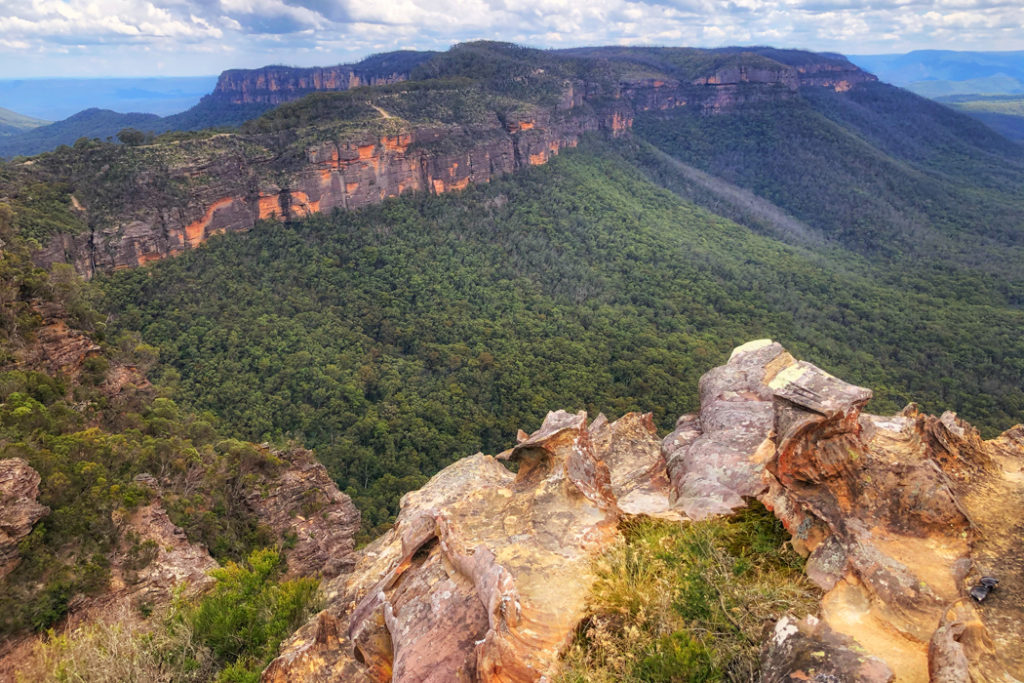
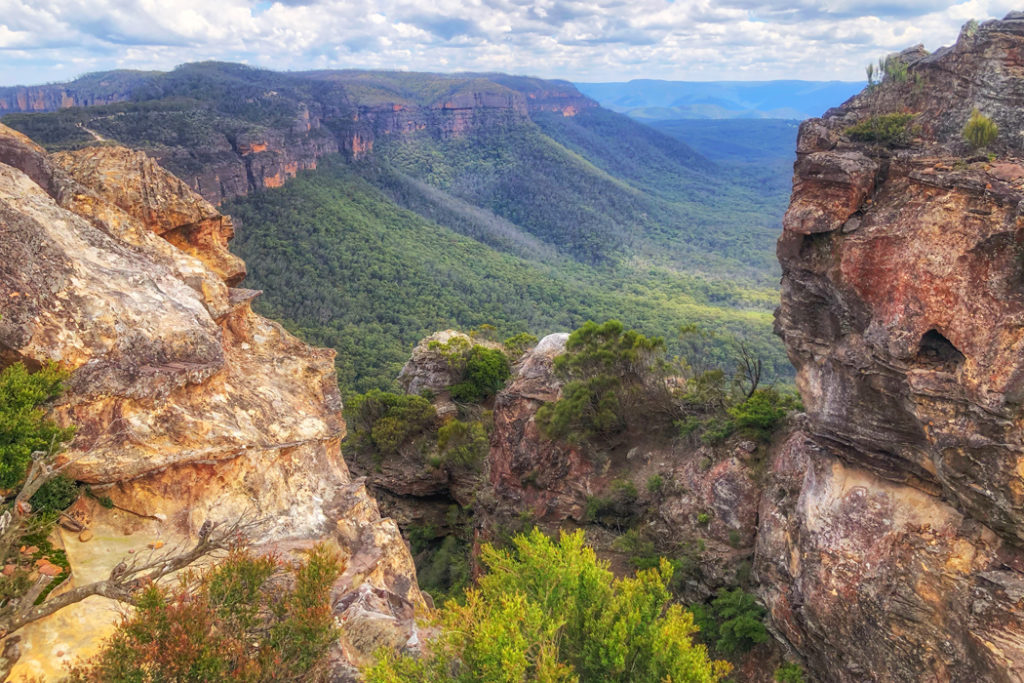
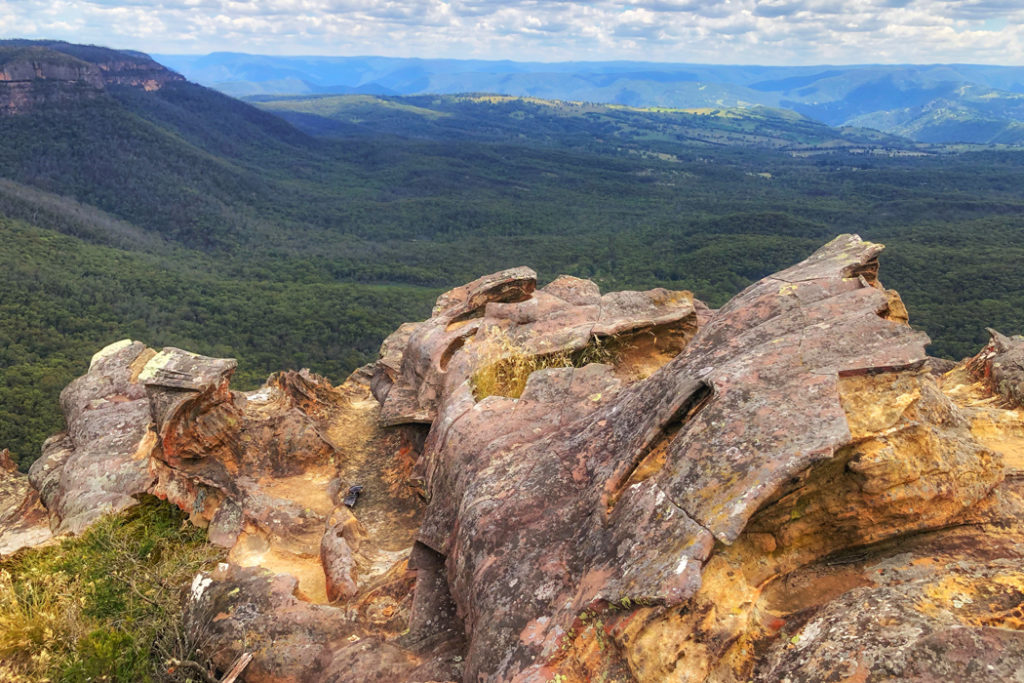
Boar’s Head Climbing Area is a very atmospheric and fun lookout that not many people know about. Not to be confused with Boar’s Head Lookout that is part of Cahill’s lookout, Boar’s Head Climbing Area is located on Boar’s Head itself, or rather across a crevice from it – Boar’s Head is a free-standing rock.
To reach the climbing area, walk 150 meters from Cahill’s Lookout along Cliff Drive towards Bear’s Head Rock (you can see it from the lookout). You will see a trail running into the bushes on your right. The Boar’s Head Climbing Area is at the end of this short trail.
Please note that this is not a designated lookout, it is unfenced and sits right on the edge of the cliff. In other words, not suitable for unsupervised children.
Because this lookout is unfenced and full of unusual rock formations, it feels very wild. There is a decent relatively flat area to walk around and to find interesting viewpoints for photographing the Narrow Neck Peninsular with ornate rocks in the foreground.
Castle Head Lookout – Mt Solitary, Katoomba
Walking time – 2 hrs (4.2 km return). Location on the map
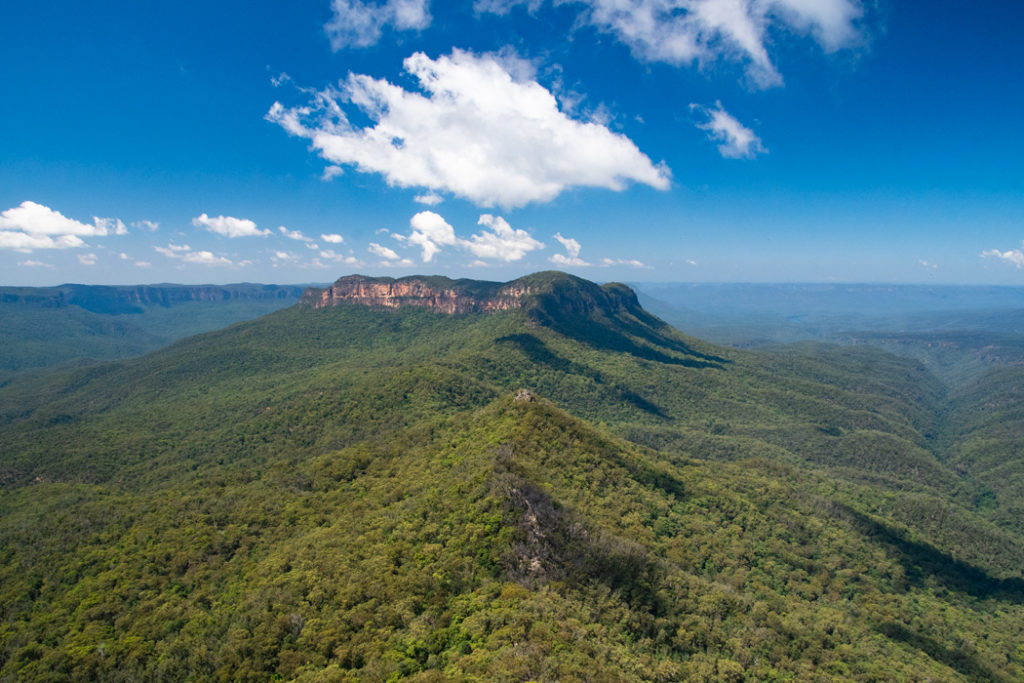
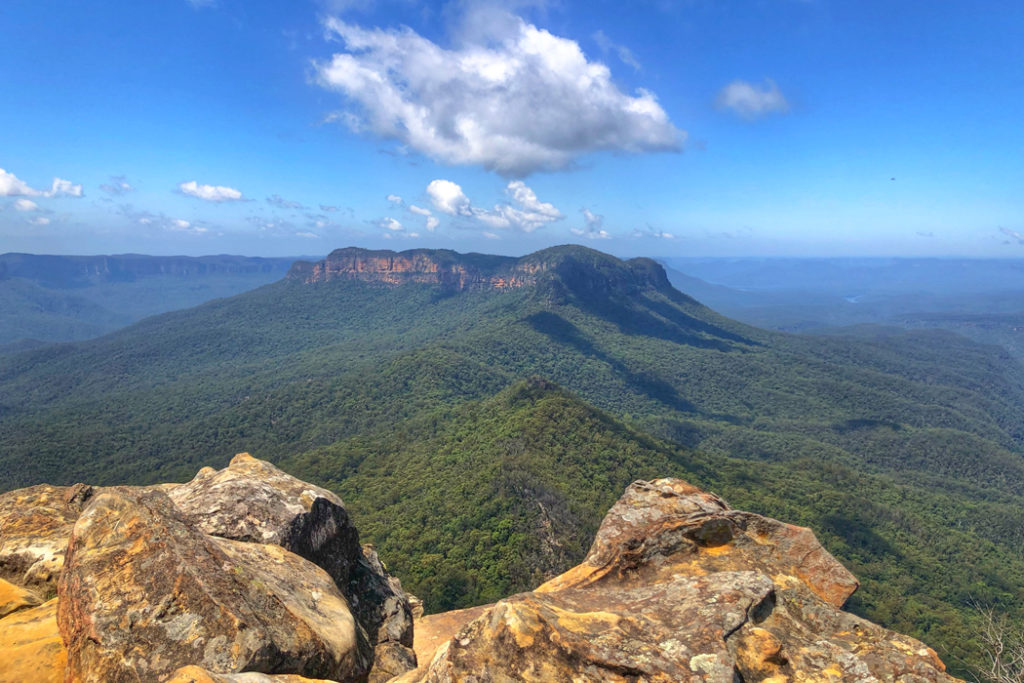
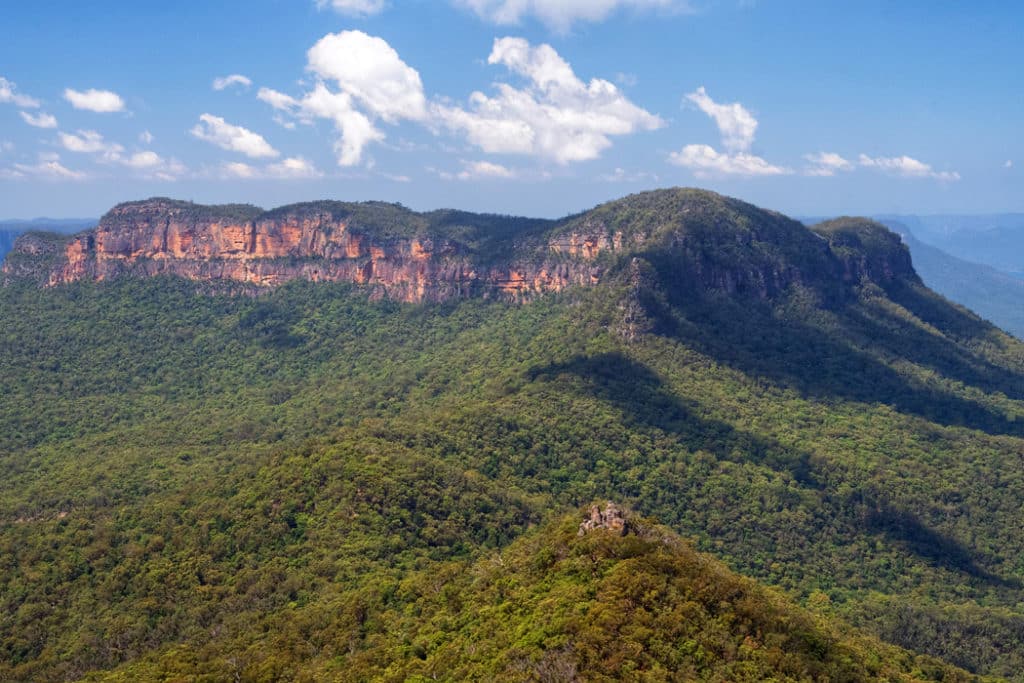
Castle Head is one of the headlands that jut out from the Narrow Neck Plateau, and the view from Castle Head Lookout at the tip of the headland is jaw-dropping.
Right in front of you are the iconic Mount Solitary and the Ruined Castle at its foot. To the right and to the left, Jamison Valley undulates in a thick green velvet carpet towards the sandstone cliffs that you’ve been walking past on the trail. And further, in the distance, the walls of the escarpment surround you like a rim of a giant volcano crater.
This is the best spot I’ve seen that lets you appreciate that the Blue Mountains are a plateau cut by deep valleys rather than a chain of mountains rising from the ground.
Castle Head is an unfenced lookout with a variety of rocks to sit or stand on. You could also explore a rocky area just to the right of the main lookout, especially if you visit on a busy day and there are a few people at the main lookout already.
Landslide Lookout – Jamison Valley, Katoomba
Walking time – 5 min (about 50 meters each way ). Location on the map
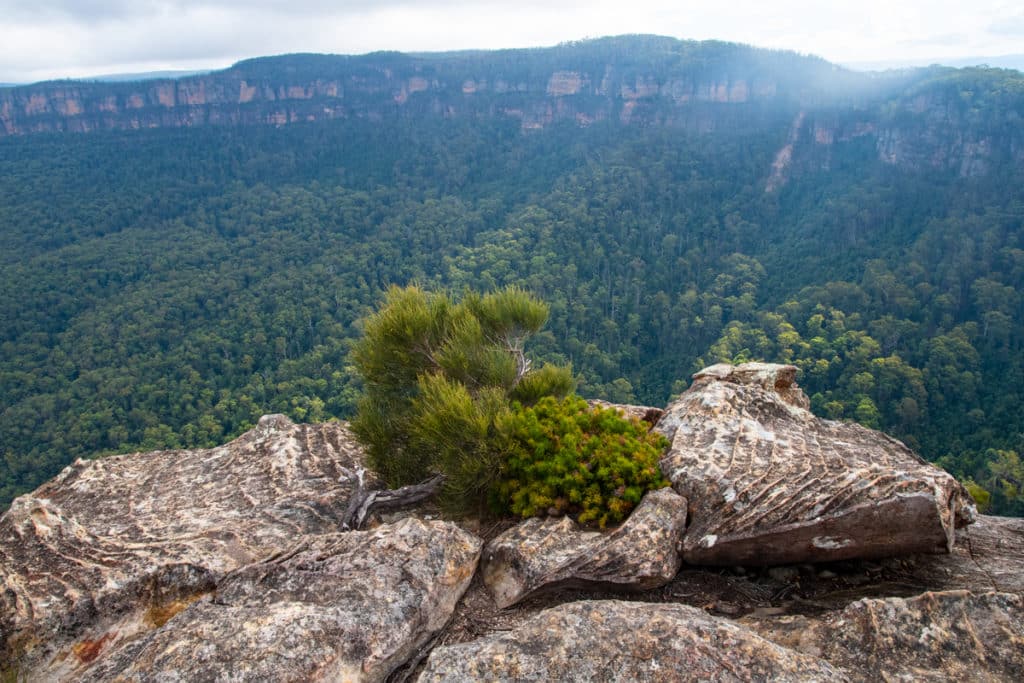
The Landslide Lookout sits above the site of the most famous landslide in the Blue Mountains. In 1931 a large fissure of rock separated from the Katoomba cliff line creating a precariously balancing semi-detached rock that a few months later collapsed into Jamison Valley leaving a sheer yellow cliff face that later became known as Dog Face.
Of course, because the lookout sits on top of the cliff, you can’t see the landslide scar from it. You can get a very good view of it from the Narrow Neck Plateau though. However, the ridgeline to the left of the official lookout is fun to explore. Follow the Cliff line for a couple of hundred meters and you will arrive at a much more interesting rock ledge that offers spectacular views of Jamison Valley, Narrow Neck Plateau and rugged cliffs in between.
There are some very ornately eroded rocks at this ledge that provide a good foreground for photography and a good perch for admiring the view. As always, be careful around unfenced cliff edges – it is a long long way to fall.
Honeymoon Bridge – Jamison Valley, Katoomba
Walking time – 1 hour (800 meters return). Location on the map.
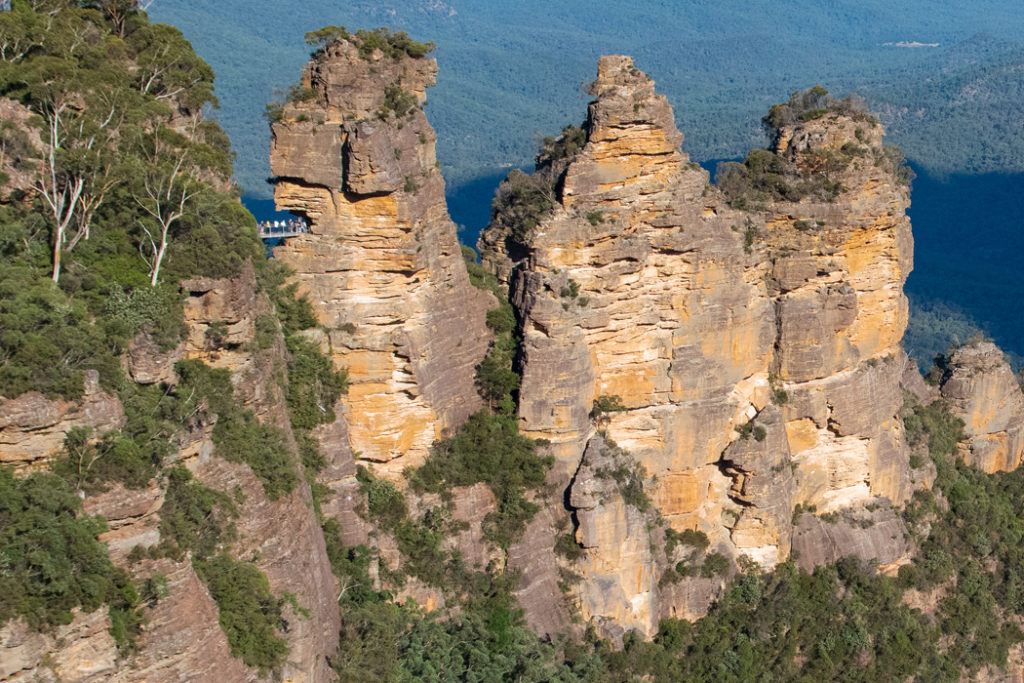
Honeymoon Bridge is one of the most unusual viewpoints in the Blue Mountains – it is located on a bridge between the escarpment and the first of the Three Sisters. To really appreciate it, you should first see the Three Sisters from Echo Point Lookout and then follow the 400-meter walk to the Three Sisters from the archway next to the Visitor Center.
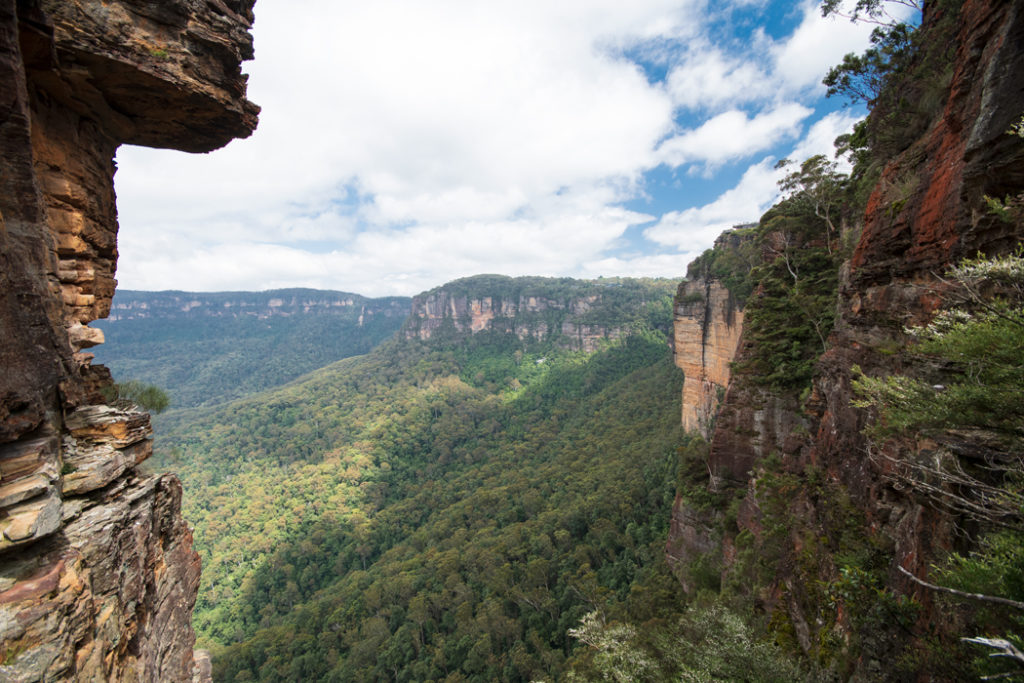
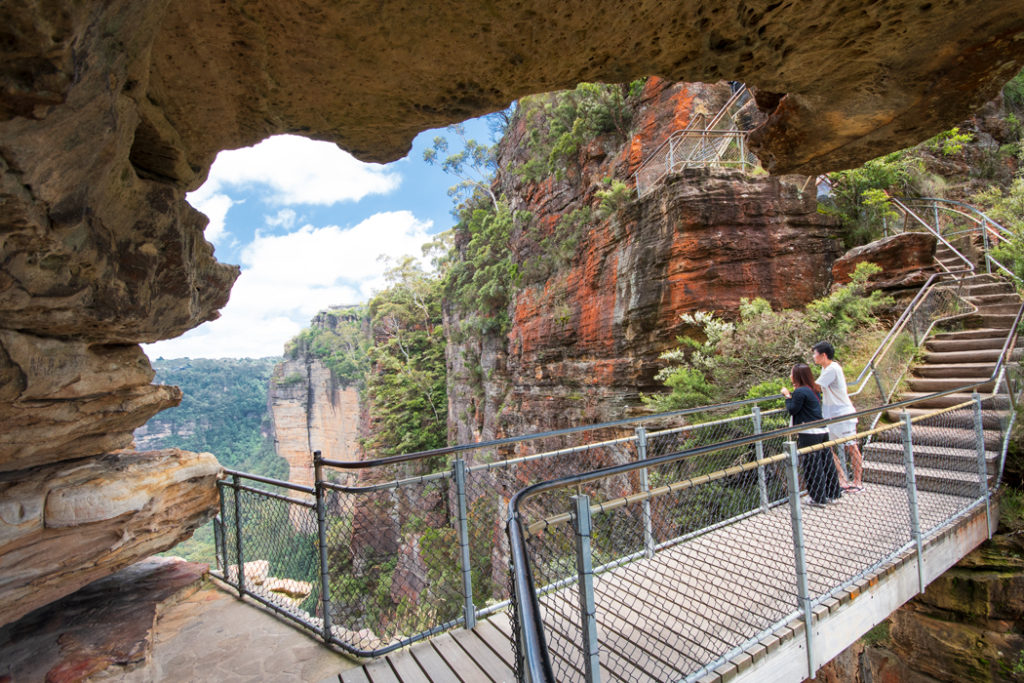
It is an easy walk to the first sister followed by a steep stairway to Honeymoon Bridge. The bridge is quite narrow and it can cat quite busy, so try to visit in the morning before the tour groups arrive or in the late afternoon. The view from the bridge is expansive, but it is the immediate proximity to the mammoth rock formations that makes Honeymoon Bridge so special. This is also the start of the Giant Stairway if you feel like a challenging walk.
View of Orphan Rock – Jamison Valley, Katoomba
Walking time – none. Location on the map.
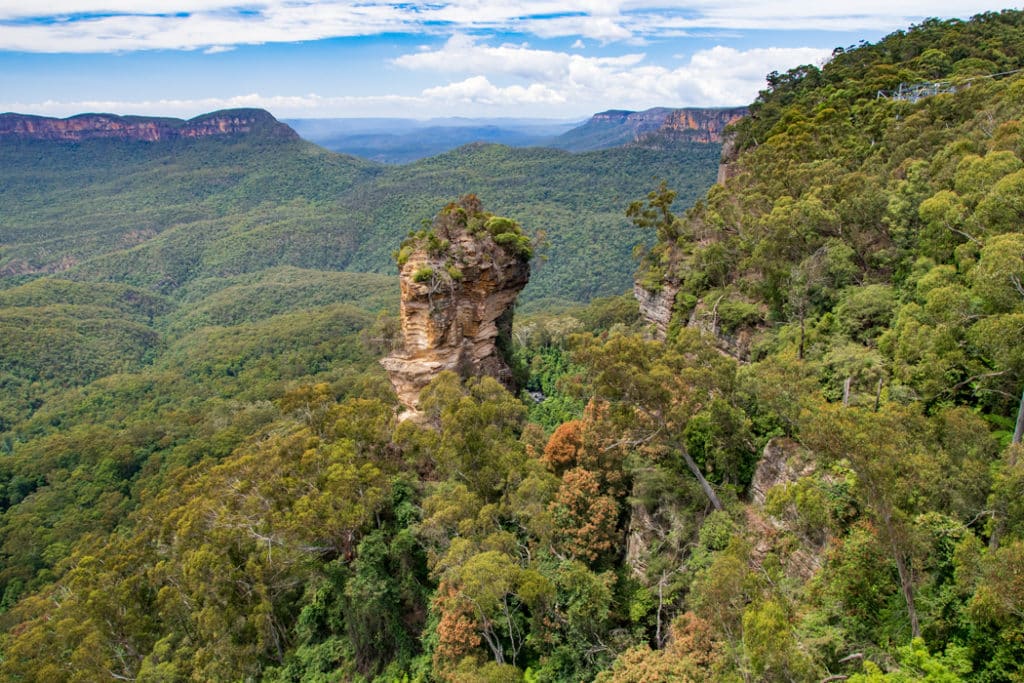
Also in the category of unusual lookouts is the view of Orphan Rock from Scenic Skyway. Technically, it is not a lookout – the only way to see this view is from Scenic Skyway cable car as it travels above Jamison Valley from Scenic World.
Orphan Rock is an impressive pillar that towers over Jamison Valley, separated from the escarpment. In the early days of tourism in the Blue Mountains (the 1890s), it was even more popular than the Three Sisters. Ladders and stairs were hewn into the rock to create a trail to the top. However, in 1974, a landslide damaged the trail and access to the Rock was never re-opened in fears that the structure was too unstable.
Today, the rock can still be accessed via the 70-year old ladders, but it is obviously unsafe and shouldn’t be attempted independently. National Parks closed access to the start of the trail. But you can get an amazing view of Orphan Rock from Scenic Skyway, not to mention the striking views of Jamison Valley and Katoomba Falls.
Therabulat Lookout – Nellie’s Glen, Katoomba
Walking time – 10 min (less than 100 meters one way). Location on the map
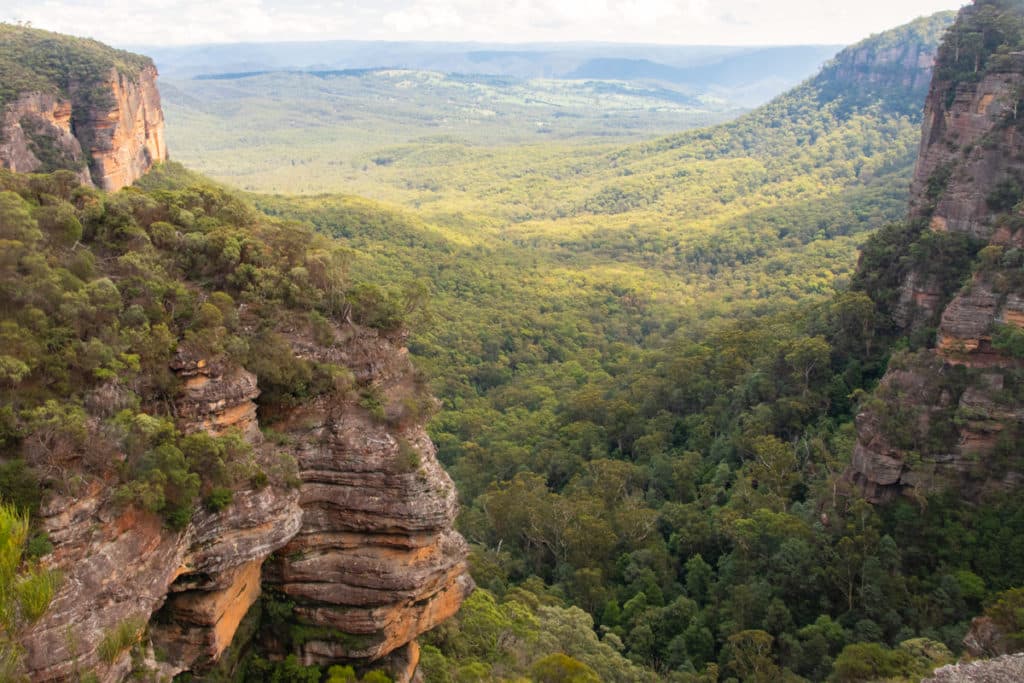
Therabulat Lookout (Dhurabulla in the local indigenous language) is named after the indigenous people who lived in the Megalong Valley. It is tucked away along the Bonnie Doon trail that starts in a very unassuming fashion at the end of a suburban street in Katoomba (Cnr of Farnells and Stuarts roads). The walk to the lookout is very short which makes the stunning view of Nellie’s Glen all the more impactful. Just because it’s so unexpected.
The view from Therabulat is framed by rugged cliffs on each side, much like the Fletchers lookout at Wentworth Falls. There is also some room for exploring the ledge on which the lookout sits. While the lookout itself is fenced, you can follow a rough trail to the right of it to an exposed cliff top and enjoy the view uninterrupted by any fences. And one of the best things about Therabulat and the nearby North’s lookouts is that you are likely to have them completely to yourself. This spot is not widely known outside of the local community.
North’s Lookout – Nellies Glen, Katoomba
Walking time – 1.5 hrs (2.2 km return). Location on the map
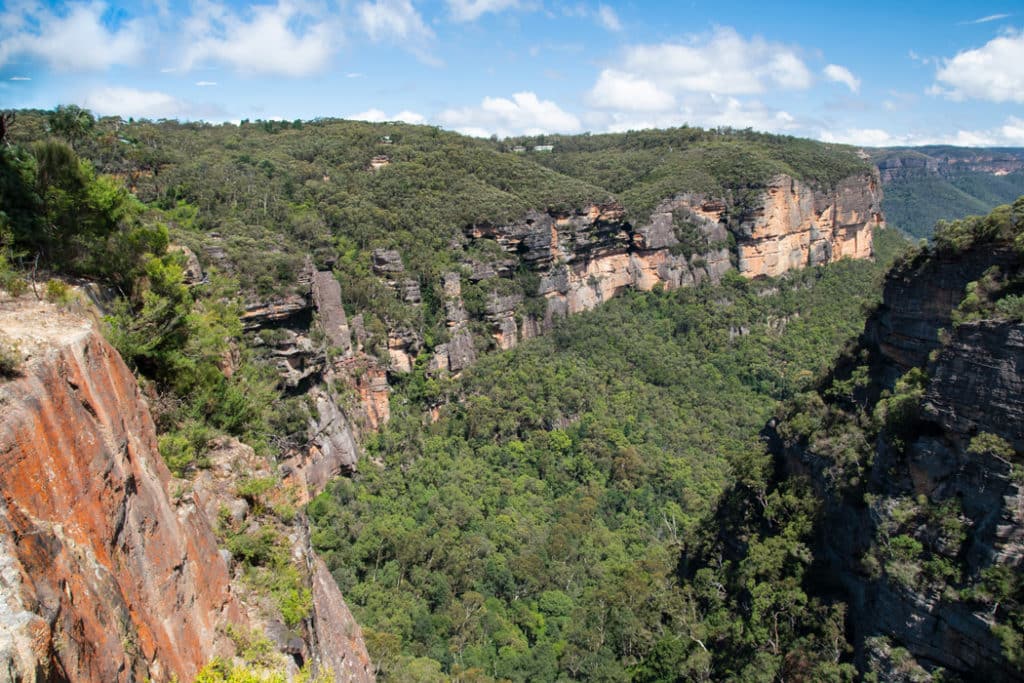
North’s lookout gives a more unusual view into Nellies Glen than Therabulat. Here you are looking into a bending tunnel-like glen from above. You can get an even more interesting perspective by climbing down to the ledge below. From this vantage point, you can see part of the sheer cliff face underneath the official lookout and appreciate just how deep the valley is and how steep the walls are.
There are two ways to reach North’s lookout. You can either park at the Explorer’s tree, walk a small section of Six Foot Track and continue to the lookout. It’s about a 20-min walk. Or you could walk here from the Therabulat lookout via a very tranquil and usually deserted cliff walk.
Govett’s Leap Lookout – Grose Valley, Blackheath
Walking time – none. Location on the map.
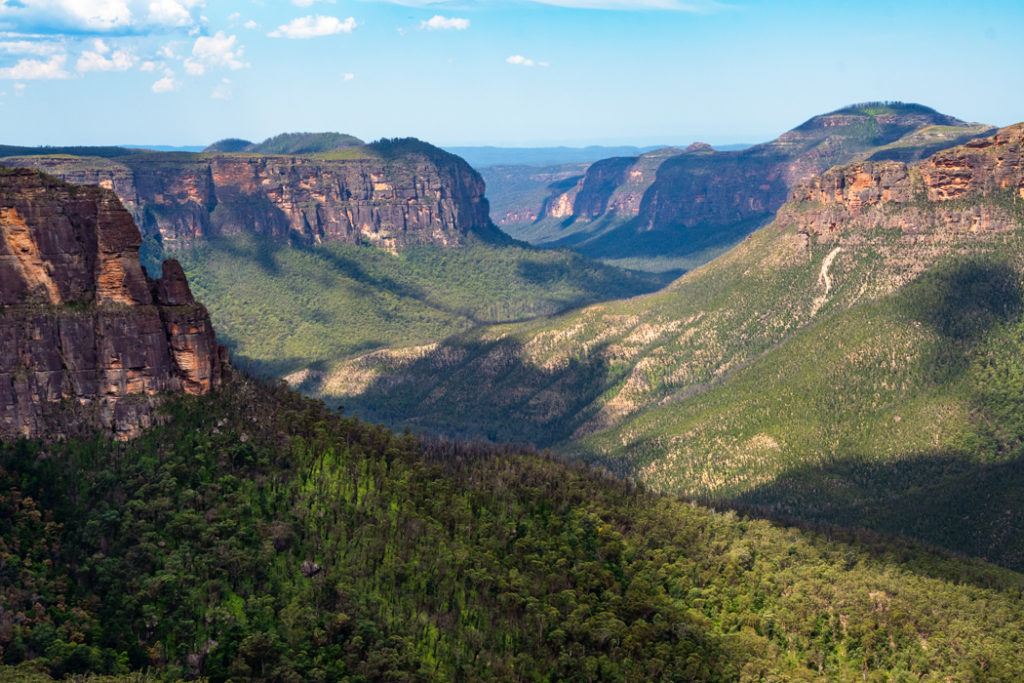
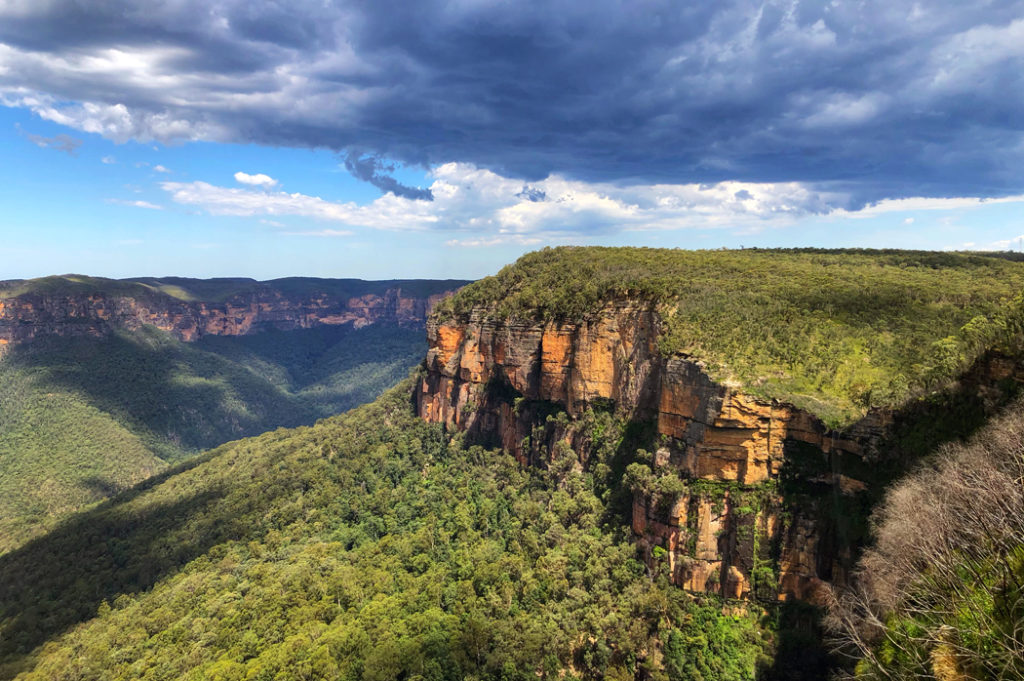
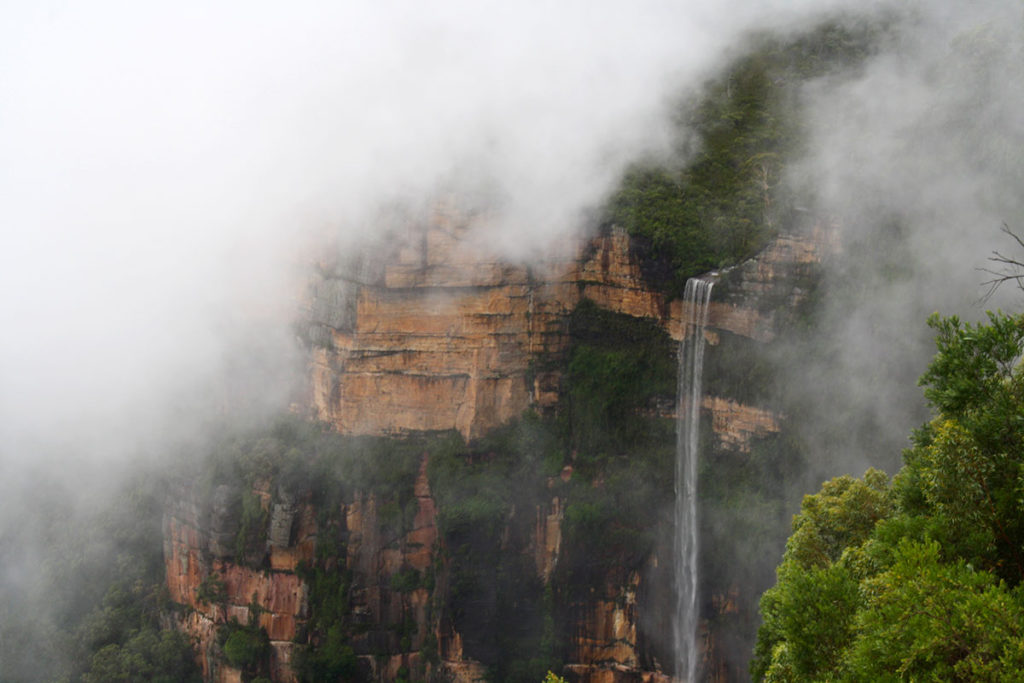
This is one of the most famous lookouts in the Blue Mountains and for a good reason – it has the best of all worlds: sweeping views of Grose Valley, sheer cliff walls, dramatically-folded landscape and Blue Mountain’s tallest single-drop waterfall. Govetts Leap falls drops 180 meters from the top of the cliff to the forested valley below. It is particularly impressive after a couple of days of decent rain. And like Evans Lookout, you can drive right up to Govetts Leap Lookout.
Despite being famous, Govetts Leap doesn’t get crowded because it’s not part of major tourist itineraries. Most people that visit it are either chasing stunning views or equally stunning bushwalks.
Govett’s Leap is even more popular for sunrise photography in winter than Evans Lookout. But it’s one of those lookouts that looks good in most weather conditions. Once, I caught it in the late afternoon of a rainy day and its moody atmosphere was very photogenic.
Evans Lookout – Grose Valley, Blackheath
Walking time – none. Location on the map
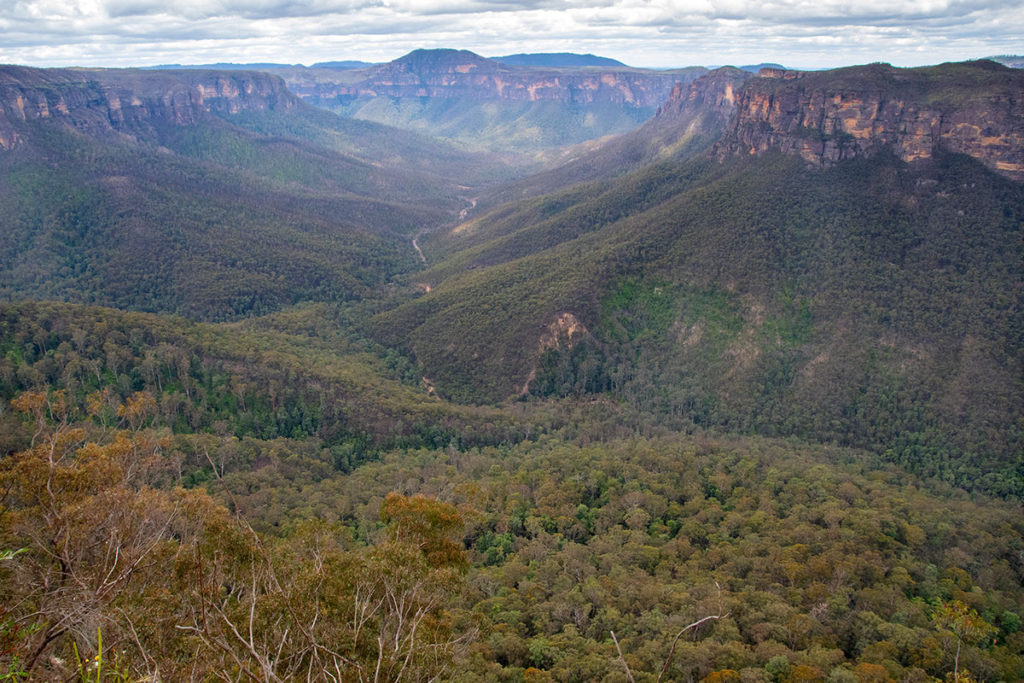
Lying at the start of the popular Grand Canyon Track, Evans Lookout overlooks the wider section of Grose Valley, taking in the undulating valley floor cut by the meandering line of Govetts Creek, and the trademark sheer sandstone cliffs towering above the valley. It is one of the most expansive views in the Blue Mountains and a popular spot with bushwalkers.
The fenced lookout area is very spacious, and even on a busy day, there’s plenty of space. To get a slightly different view, walk over to the neighbouring Valley View Lookout.
In winter, Evans lookout is a popular spot at sunrise, especially with photographers. It is a magical sight when the valley is shrouded in mist and low-hanging clouds after a cold night and as the sun rises, you get a view from above the clouds.
Bushranger’s Cave – Kanimbla Valley, Mt Victoria
Walking time: 40 min (1km) return. Location on the map.
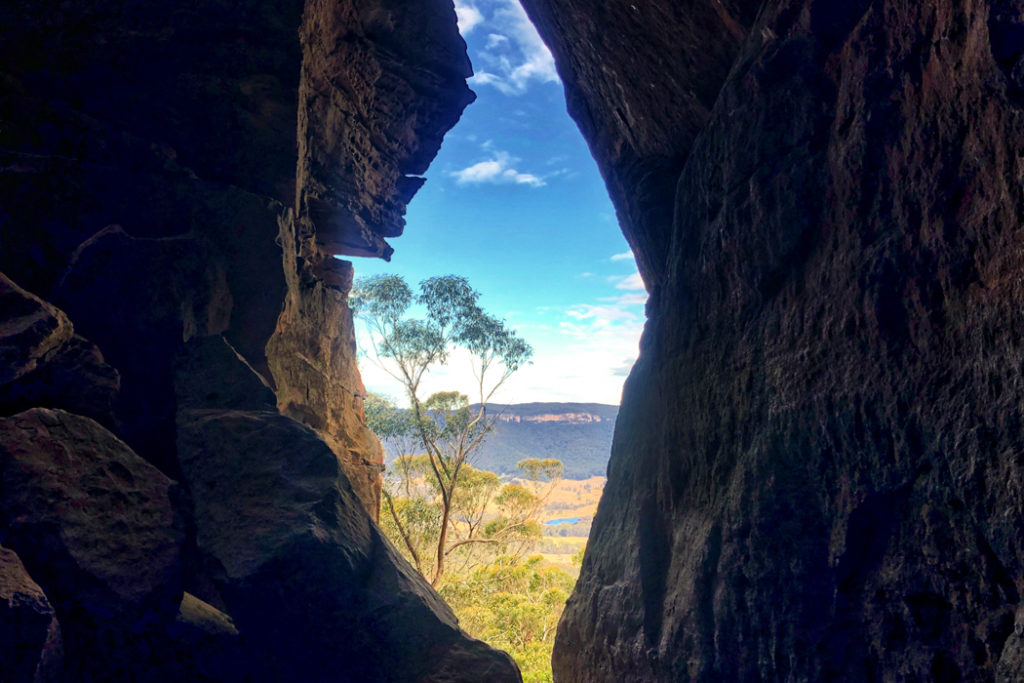
As far as unusual lookouts go, caves in the face of the cliff offer some of the most dramatic framings. And while there are many caves in the Blue Mountains, most of them do not look out onto expansive valleys. But the Bushrangers Cave at Mount Victoria does just that. It is a fascinating cave to explore and its tall and narrow mouth provides the perfect picture frame for the view of Kanimbla Valley below.
The cave is easily reached from Mount Victoria village. You can walk to it from the train station (1.8km each way), if you are visiting the mountains by train, or you can park at Pulpit Rock carpark on Kanimbla Valley Road. From the carpark, it is just over a kilometre return walk to the cave.
The trail starts as an easy walk in the bush, then becomes a steep switchback track and at the end, there is a short scramble involved. But once you are in the cave, it is a very atmospheric spot. And because the cave is carved into the face of the cliff, the view that opens up from its mouth is incredible.
Walls Lookout – Grose Valley, Bilpin
Walking time – 1 hr (2.6 km return). Location on the map
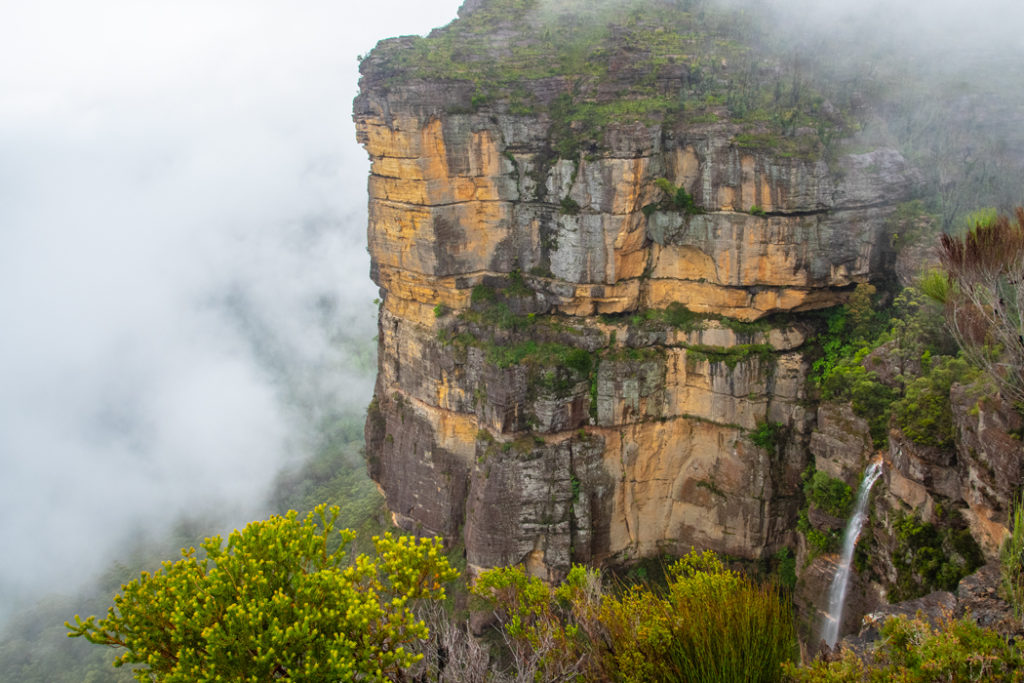
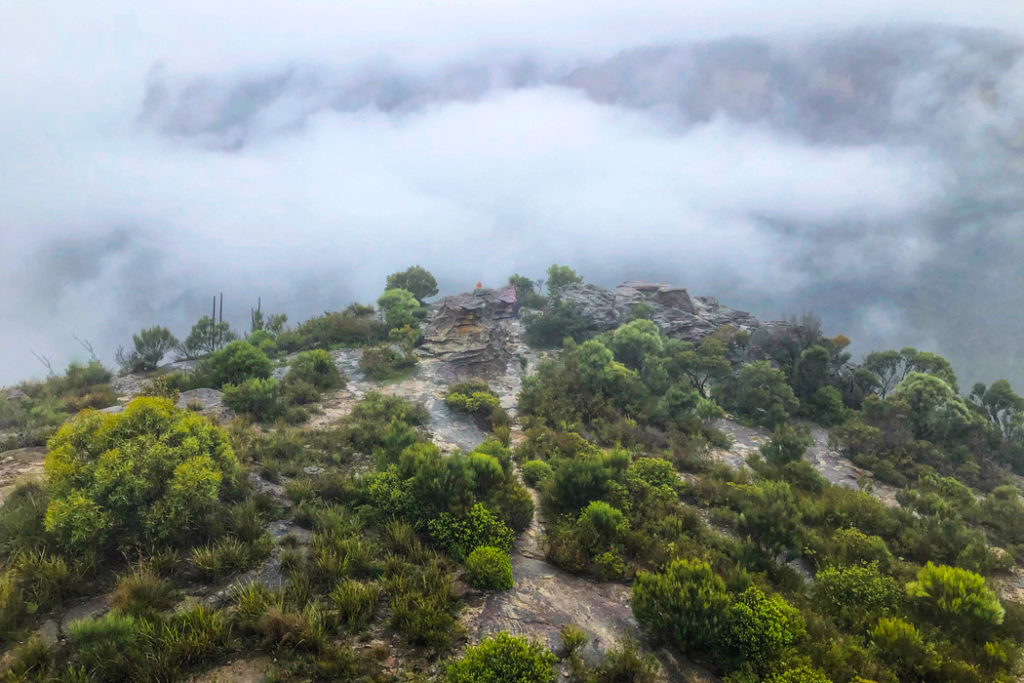
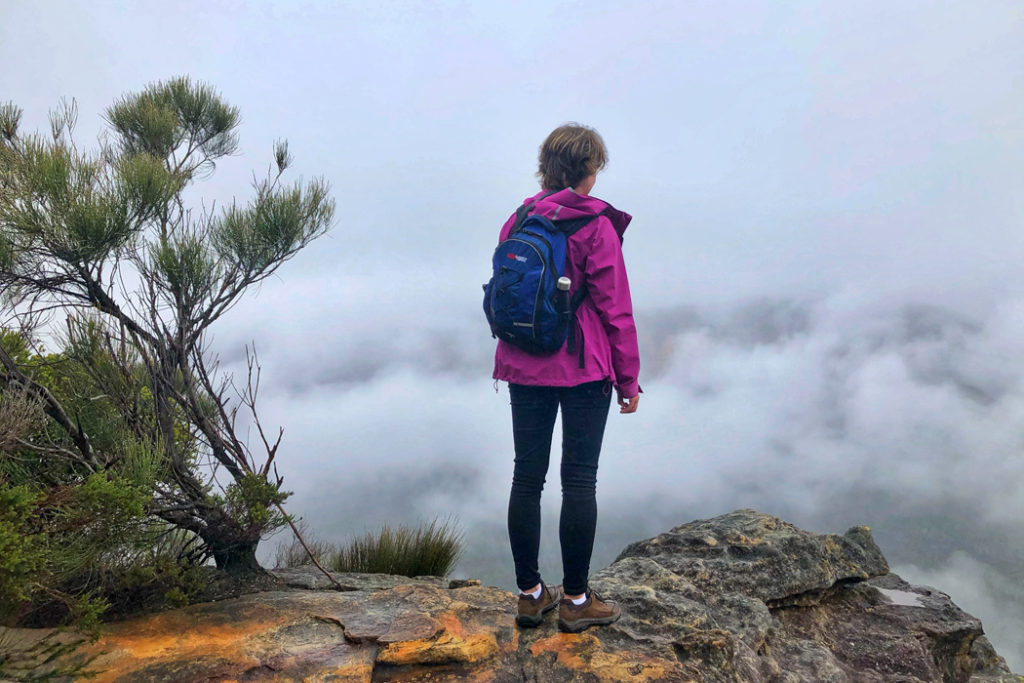
The Walls Lookout is a stunning and aptly-named spot and one of my favourite lookouts in the Blue Mountains. It overlooks a narrower section of Grose Valley and the rugged walls of the escarpment on the other side of the valley. The lookout is sprawled over a small hill that’s bookended by sheer sandstone walls rising from the valley. So whichever way you look, you are surrounded by monolithic walls. There are no fences, no signs on the lookout itself or on the 1.3km trail leading to it. Just the rugged beauty of nature.
The Walls lookout is incredibly picturesque in any weather. I returned here to take some images for this post and found the lookout shrouded in thick mist after the rain. The valley and the opposite wall of the escarpment were lost from view beyond the white blanket of mist. The walls on the sides of the lookout kept appearing and disappearing as the mist swirled around them.
It was an incredibly mystical and atmospheric sight. Two waterfalls formed by the accumulated rainwater were running down the cliffs on each side. And the only reason we could see anything at all was that the rock walls stand so close to the lookout. The other lookouts we visited that day had zero visibility.
This lookout doesn’t get crowded either. It is further away from the main tourist areas in the mountains, it can’t be reached by public transport, it takes a 1.3 km walk to get here and it’s big enough to find your own perch even when there are other people around.
Hassans Walls – Hartley Vale, Lithgow
Walking time -3 min (700 meters). Location on the map.
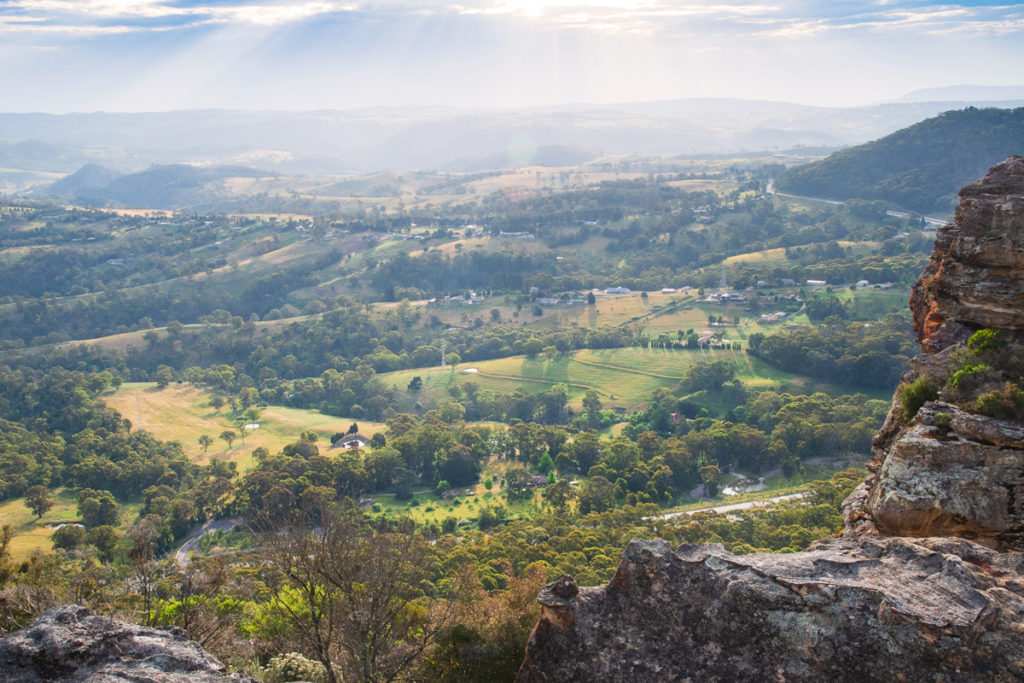
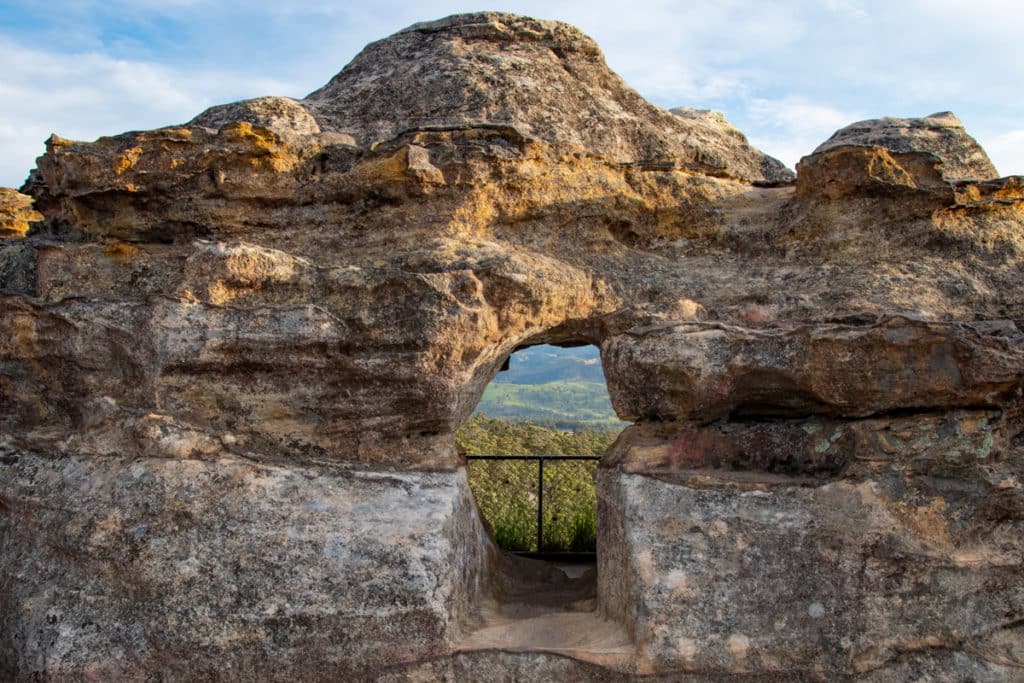
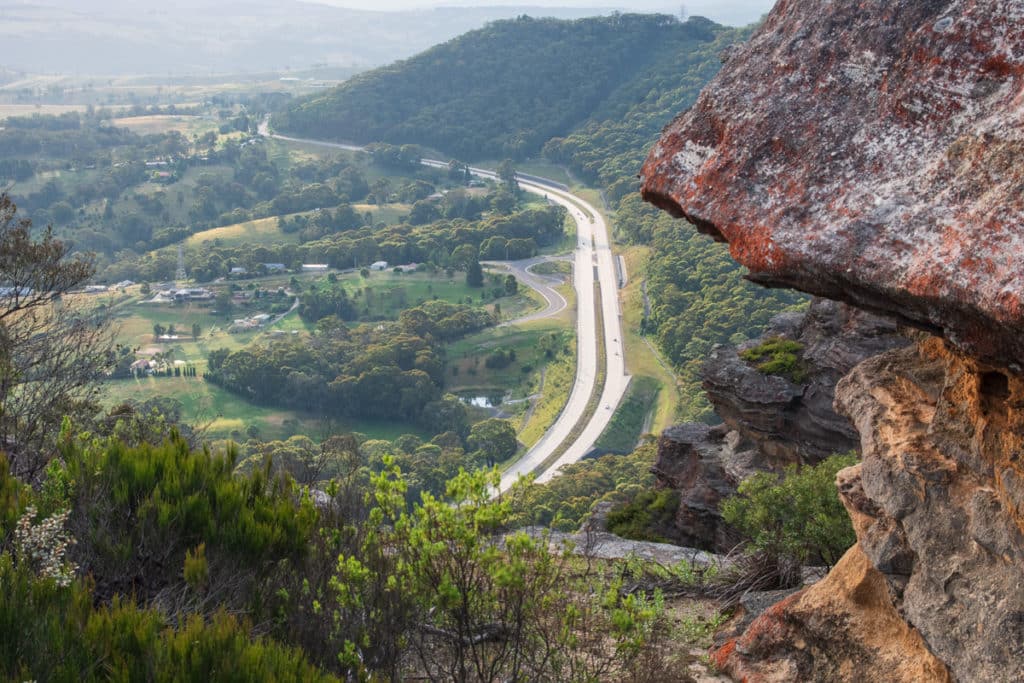
One of my favourite Blue Mountains lookouts is Hassans Walls Lookout in Lithgow. It extends quite far from the cliff-line and gives a mesmerizing view of Hartley Vale all the way to Mount Wilson, Mount York, Mount Tarana and Mount Blaxland. At 1,100 meters above sea level, it is also one of the highest lookouts in the Blue Mountains, so the view is truly panoramic.
What makes Hassans Walls Lookout even more amazing is that it offers a variety of different viewpoints. There is a little cave just to the right of the main lookout that offerers a different perspective as you look down into the valley through the mouth of the cave. The path from the carpark to the lookout also reveals different viewpoints. I quite like the view of the Great Western Highway as it circles Hartley Vale at the foot of the towering cliffs.
The best time to visit Hassans Walls is in the late afternoon when the sun casts a golden glow over the valley and the cliffs.
Wolgan Valley Lookout – Wolgan Valley, Lithgow
Walking time – none. Location on the map.
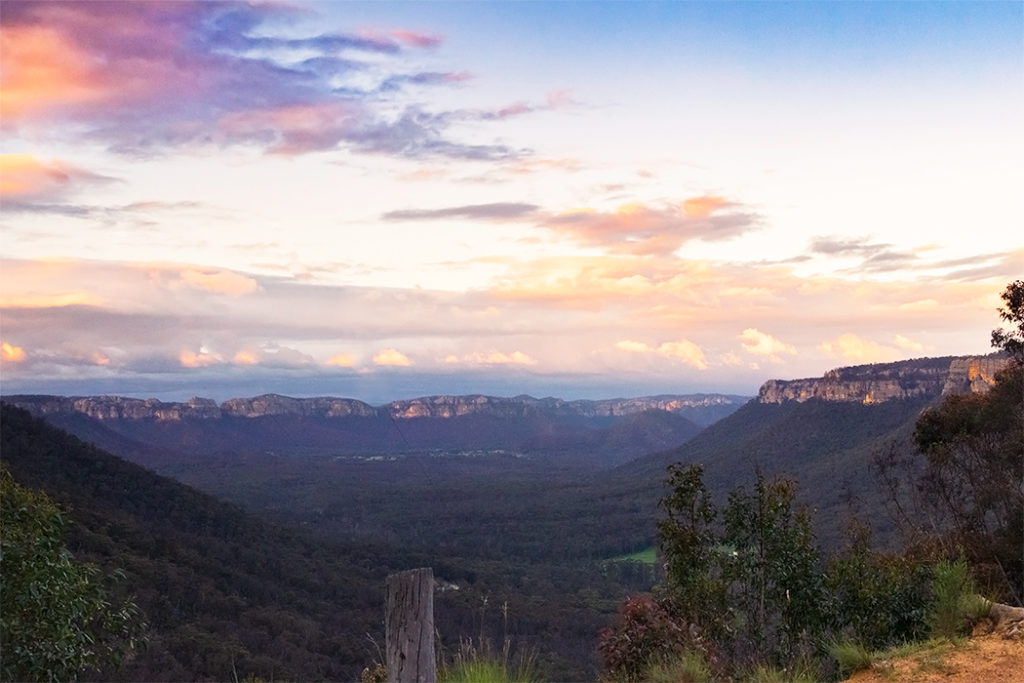
Wolgan Valley is one of the Blue Mountains’ most picturesque secrets. Home to the Emirate’s luxurious One & Only, Wolgan Valley is nestled along Wolgan River in the Lithgow Region. And unlike most of the lookouts on this list, you can enjoy Wolgan Valley Lookout from your car’s window (although, I would suggest stepping out and soaking in the view). It is located on Wolgan Road, where it descends from the escarpment to the valley. The lookout is not signposted, so use the map pin to locate it. Coming from Lithgow, it is 300 meters further along from Wolgan Gap.
If you find yourself in the area in the afternoon, follow the road down to the valley – it is a very scenic drive along a sealed road up to the One & Only. And then return to the lookout for sunset when the tops of the escarpment start to glow in rich golden color.
Another good viewpoint of Wolgan Valley is located along the Glow Worm Tunnel track. If you are keen to do a bushwalk in the area, check my guide to the Glow Worm Tunnel track.
Carlotta Arch – Jenolan Valley & Blue Lake, Jenolan Caves
Walking time – 30 min (828 meters return). Location on the map.
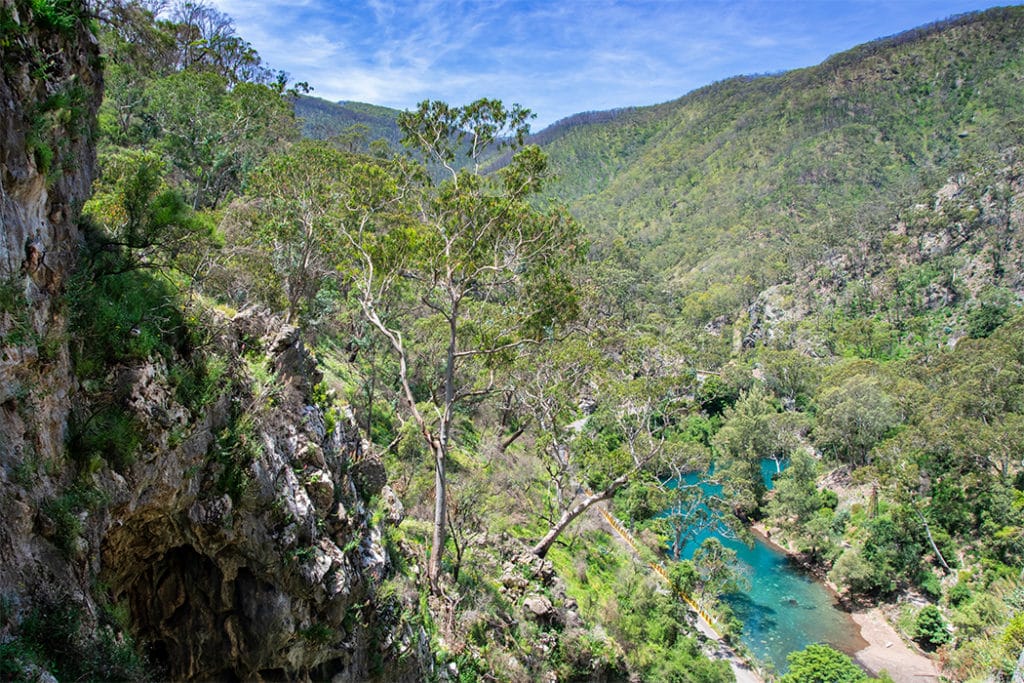
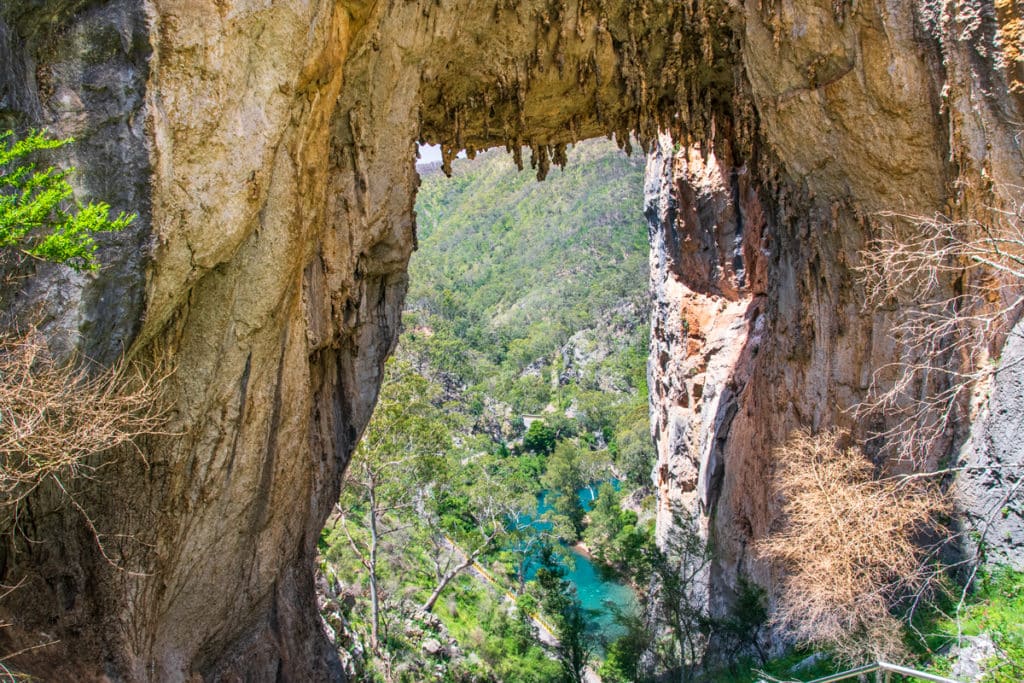
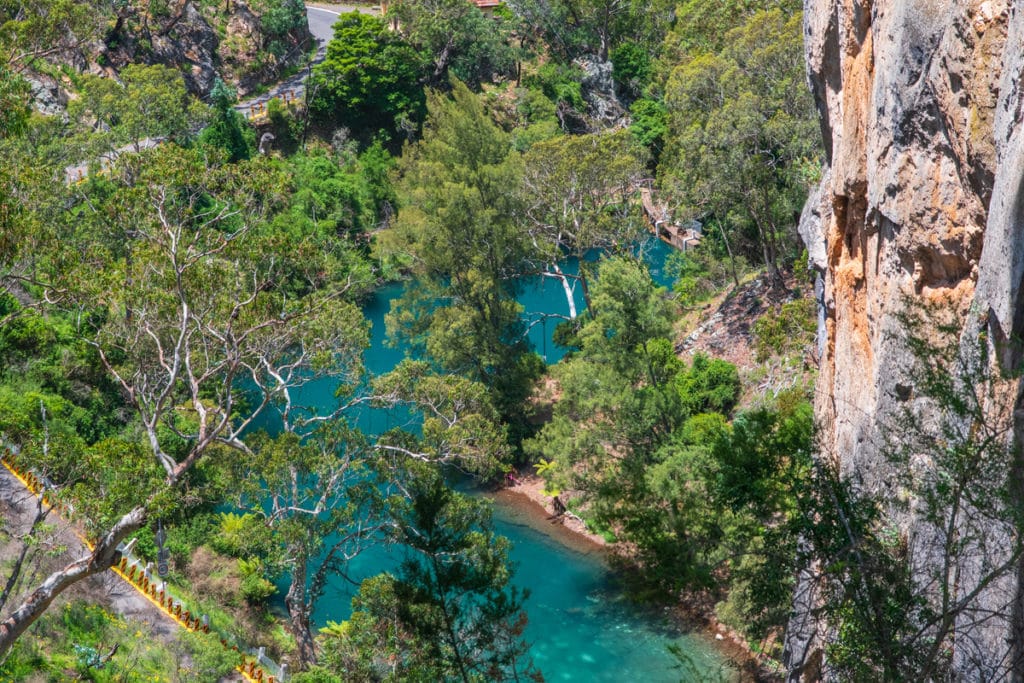
Carlotta Arch is a different kind of lookout. Instead of the sweeping 180-degree valley views, it offers the view of the vividly-coloured Blue Lake through a dramatic remnant of a cave. And once you step through the arch, you’ll get the views of the Jenolan Valley.
Unlike most of the Blue Mountains lookouts that are characterized by the sheer sandstone cliffs, the area around Jenolan Caves is dominated by limestone. That’s why you get so many crystal formations in Jenolan Caves. And you can see some small stalactites hanging from the roof of Carlotta Arch.
The walk to the arch from Jenolan Caves House is steep but it’s not long. And the charming view of the Victorian-era hotel perched on the side of a forest-covered mountain keeps you distracted from the climb. If you are keen to visit one of the caves at Jenolan (and you absolutely should), check out my guide to the Orient Cave, arguably the most beautiful cave in the complex.
Kanangra Walls Lookout – Kanangra-Boyd NP
Walking time – 20 min return. Location on the map.
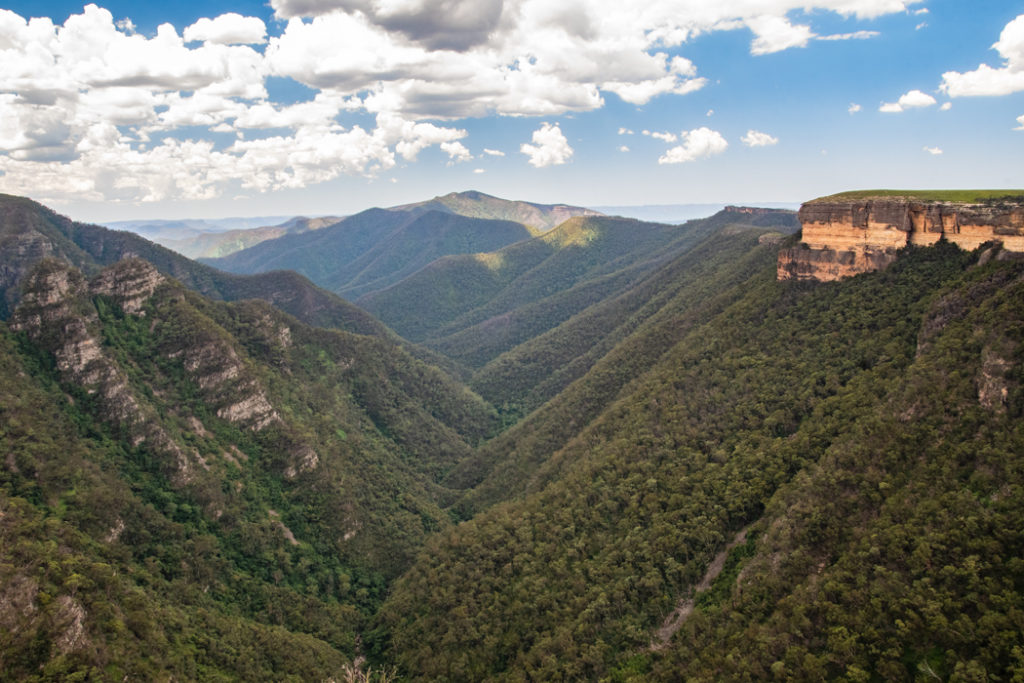
Kanangra-Boyd National Park is one of the wildest areas in the Greater Blue Mountains Area and the unfenced Kanangra Walls lookout gives you the perfect opportunity to get a birds-eye view of this rugged wilderness. The jaw-dropping view from the lookout takes in the epic folds of Kanangra Deep bookended by Thurat Spires on the left and the sheer bulk of Kanangra Walls on the right.
For all its ruggedness, Kanangra Walls lookout is located within a 10-min walk of the car park. Although you do need a 4×4 to get to the carpark, unless the road has been recently graded.
Lower Blue Mountains
Lower Blue Mountains generally don’t have the kind of dramatic lookouts that the Blue Mountains are famous for, but there are quite a few atmospheric viewpoints to check out.
Mount Portal Lookout – Nepean River, Glenbrook
Walking time – none. Location on the map.
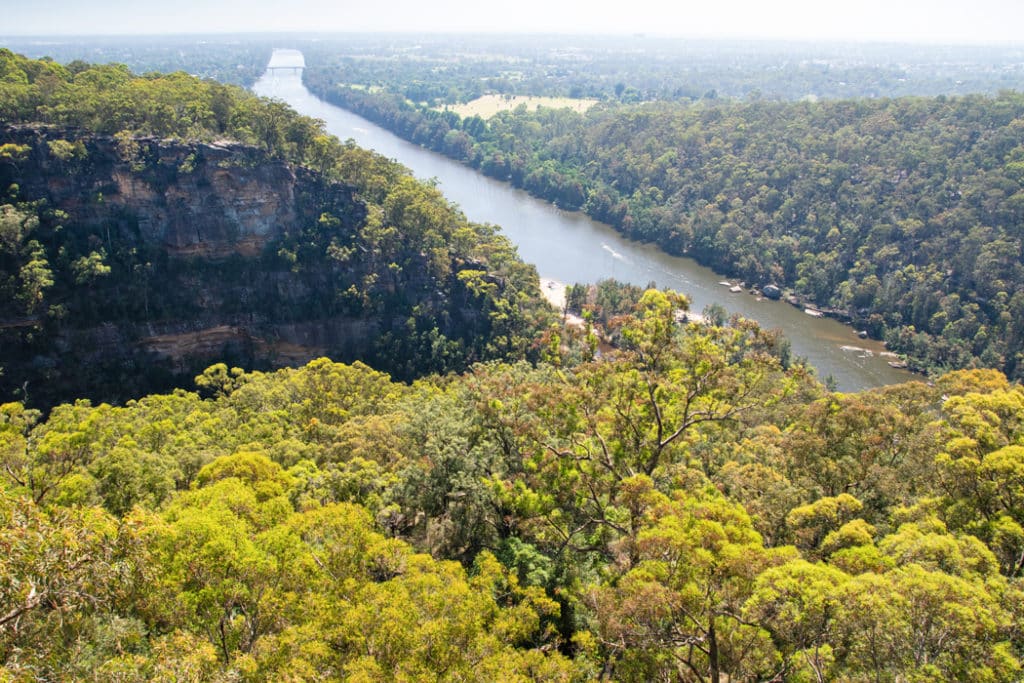
The views in the Lower Blue Mountains are different from the vast valleys of the Upper Blue Mountains, not as grand, not as sweeping, but impressive in their own way. Perched on top of the ridge in Glenbrook National Park, the Mount Portal lookout offers magnificent views of the junction between Glenbrook Gorge and the Nepean River. The sweeping view stretches to the Cumberland Plain and the outskirts of Western Sydney.
If you brought your lunch, the flat rock area around the lookout is a great spot for a picnic, just make sure not to take over the abseilers area – it’s clearly marked and fenced off. As you admire the view, keep an eye out for Peregrine falcons – they like to nest on the steep walls of the gorge.
Tunnel view Lookout – Fairlight Gorge, Gleenbrook
Walking time – 30 mins (420 meters return). Location on the map.
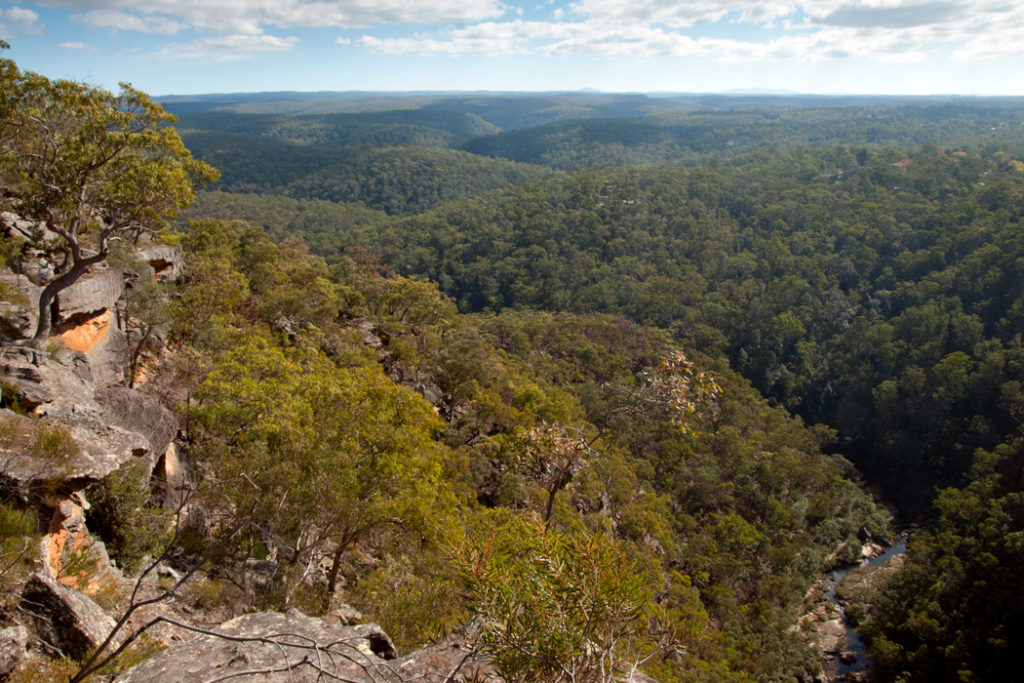
Located on the way to Mount Portal Lookout, Tunnel View Lookout in Glenbrook is one of the prettiest lookouts in the Lower Blue Mountains.
The view from this lovely lookout stretches on forever, over the deep Fairlight Gorge with the Nepean River running across the bottom. On the far side of the gorge, you can just see the hill through which the train tunnel has been constructed. The hill, however, is not very prominent, and if I was naming this lookout, I’d call it ‘gorge view’ or ‘river view’.
And there you have it – a range of different kinds of lookouts in the Blue Mountains. Which do you prefer: the iconic highlights or the hidden gems?
More things to do in the Blue Mountains
- The Lost World of the Grand Canyon Track in the Blue Mountains
- Blue Mountains by Train: Walks, Views and Waterfalls
- Blue Mountains Jenolan Caves – how to explore the world’s oldest crystal caves
- The Giant Stairway and the Dardenelles Pass – An Epic Walk in the Blue Mountains
- Prince Henry Cliff Walk in the Blue Mountains – Epic Views and Waterfalls
- Echo Point to Scenic World walk in the Blue Mountains
- Best way to visit Wolgan Valley & Lithgow Glow Worm Tunnel
- South Lawson Waterfall Circuit Walk – One Walk, Five Waterfalls
- Finding Fireflies and Glow Worms in the Blue Mountains
- Glow worms and Waterfalls of Horseshoe Falls Walking Track in Hazelbrook

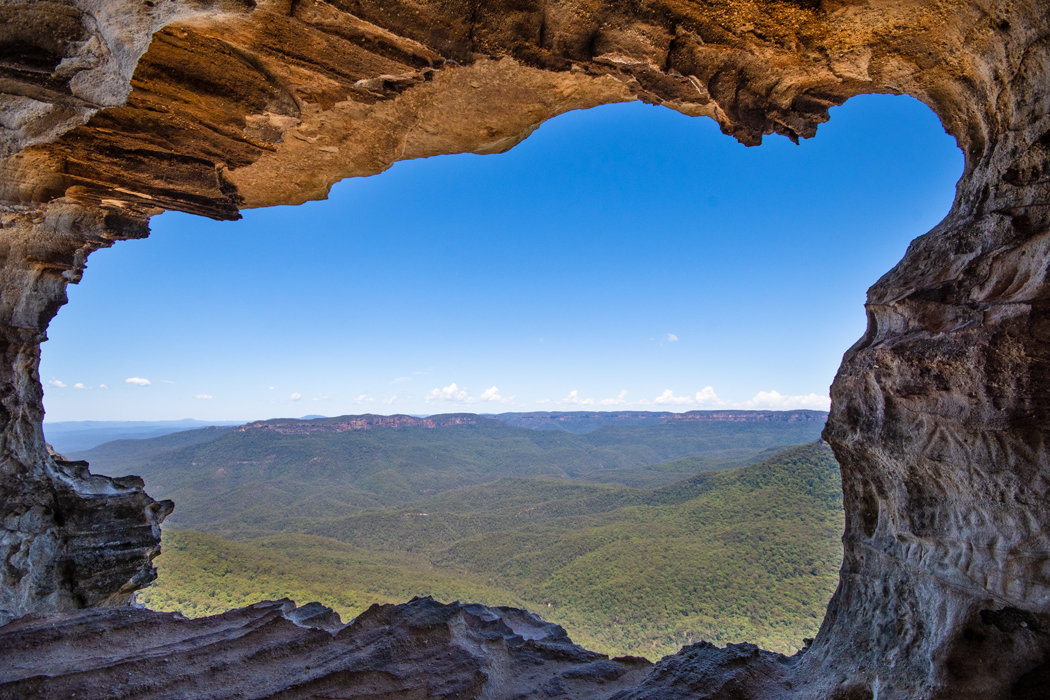
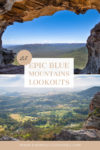
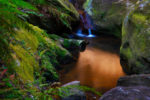
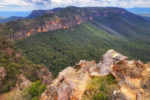
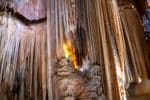
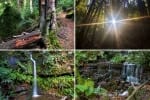
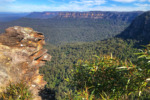
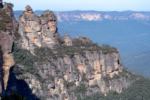
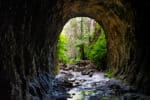
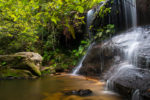

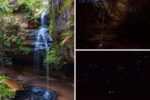
Another well documented effort. Appreciate the time and effort you’ve put into this (even though you did miss a couple). Cheers, Ian
Thank you, Ian. Yes, there are still a few spectacular spots to add, particularly around the Blackheath area. Which are your favourite ones out of those that are not mentioned here yet?
Wow this place is absolutely stunning! Definitely landed on my bucket list.
Wow all of these views are incredible! I would love to spend a few days hiking this area.
What a beautiful collection of viewpoints. I love the diversity of high points, especially the ones with waterfalls. And I’m always an admirer of arches. Beautiful post.
Thank you, Karen. I’m also a fan of unusual rock structures :)
Wow! These are stunning! And Princess Rock looking over that waterfall is just something else. Beginning to feel I need a trip to Australia in the future!
The Blue Mountains won’t disappoint :)!
We were in the Blue Mountains last April and we figured we missed a lot (we only had a day) but now we know for sure! Love seeing these pictures again :)
That’s the beauty of the Blue Mountains – no matter how much of them you explore, there is always something else to see.